Financial Ratio Analysis
VerifiedAdded on 2020/01/23
|18
|6146
|117
Report
AI Summary
The assignment presents a comparative analysis of financial ratios for two companies. It includes calculations and interpretations of key ratios such as Gross Profit Ratio (GPR), Net Profit Ratio (NPR), Current Ratio, Quick Ratio, Debt-Equity Ratio, Fixed Asset Turnover Ratio, Net Asset Turnover Ratio, Inventory Turnover Ratio, Operating Cash Flow Ratio, and Interest Coverage Ratio. Students need to analyze these ratios to understand the financial health, liquidity, solvency, efficiency, and profitability of both companies.
Contribute Materials
Your contribution can guide someone’s learning journey. Share your
documents today.

Financial Decision Making
1
1
Secure Best Marks with AI Grader
Need help grading? Try our AI Grader for instant feedback on your assignments.

Table of Contents
INTRODUCTION................................................................................................................................4
PART 1..................................................................................................................................................4
Stating the financial performance of Elton Plc by making analysis of final accounts via ratio
analysis ............................................................................................................................................4
Part 2.....................................................................................................................................................9
Assessing the viability of business expansion through investment appraisal techniques................9
Giving advise to the Board of Directors about the non-monetary factors which company needs to
undertake before entering in international market.........................................................................11
Stating the sources of finance available to Elton Plc for its expansion project.............................12
CONCLUSION..................................................................................................................................13
References..........................................................................................................................................14
2
INTRODUCTION................................................................................................................................4
PART 1..................................................................................................................................................4
Stating the financial performance of Elton Plc by making analysis of final accounts via ratio
analysis ............................................................................................................................................4
Part 2.....................................................................................................................................................9
Assessing the viability of business expansion through investment appraisal techniques................9
Giving advise to the Board of Directors about the non-monetary factors which company needs to
undertake before entering in international market.........................................................................11
Stating the sources of finance available to Elton Plc for its expansion project.............................12
CONCLUSION..................................................................................................................................13
References..........................................................................................................................................14
2
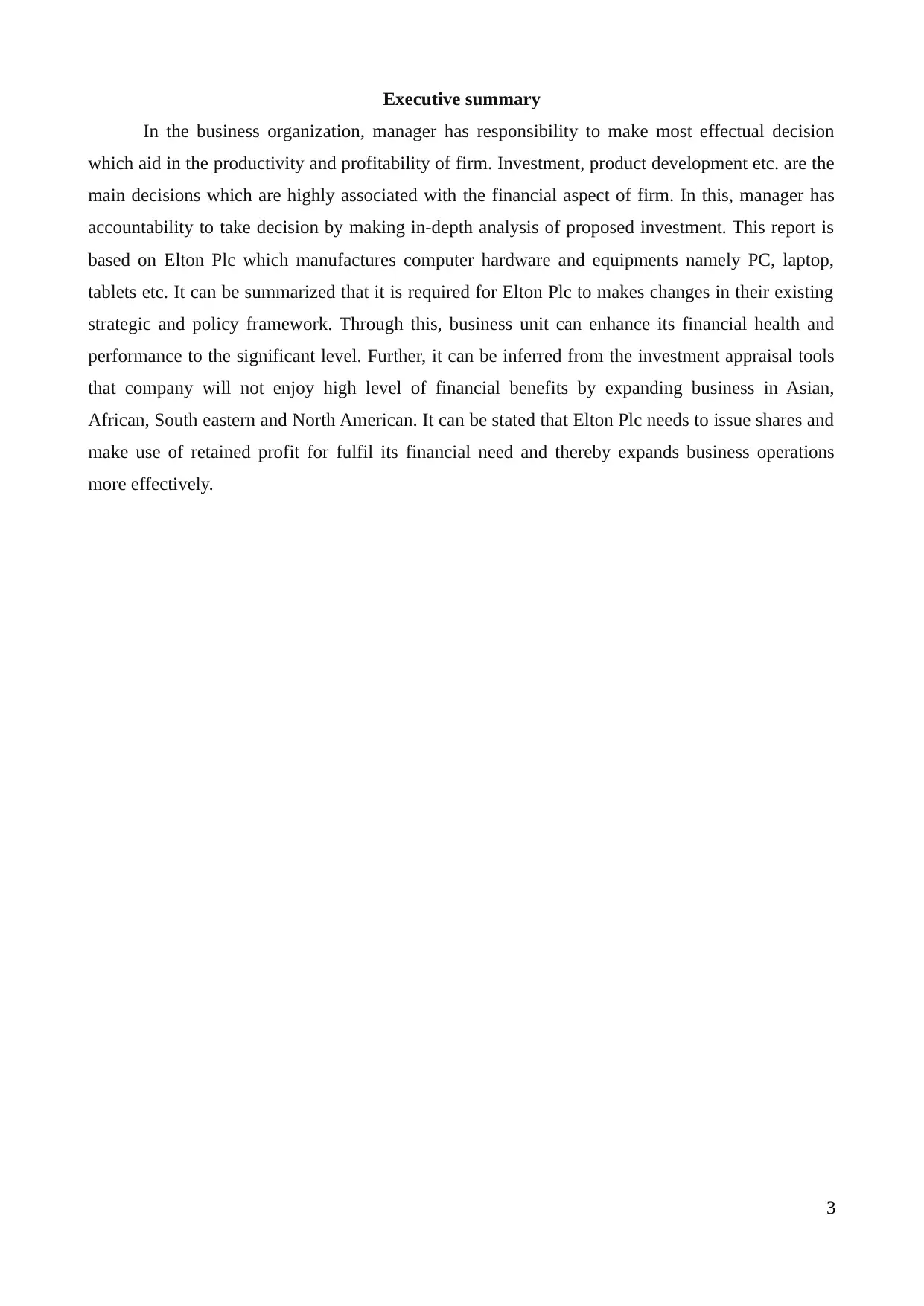
Executive summary
In the business organization, manager has responsibility to make most effectual decision
which aid in the productivity and profitability of firm. Investment, product development etc. are the
main decisions which are highly associated with the financial aspect of firm. In this, manager has
accountability to take decision by making in-depth analysis of proposed investment. This report is
based on Elton Plc which manufactures computer hardware and equipments namely PC, laptop,
tablets etc. It can be summarized that it is required for Elton Plc to makes changes in their existing
strategic and policy framework. Through this, business unit can enhance its financial health and
performance to the significant level. Further, it can be inferred from the investment appraisal tools
that company will not enjoy high level of financial benefits by expanding business in Asian,
African, South eastern and North American. It can be stated that Elton Plc needs to issue shares and
make use of retained profit for fulfil its financial need and thereby expands business operations
more effectively.
3
In the business organization, manager has responsibility to make most effectual decision
which aid in the productivity and profitability of firm. Investment, product development etc. are the
main decisions which are highly associated with the financial aspect of firm. In this, manager has
accountability to take decision by making in-depth analysis of proposed investment. This report is
based on Elton Plc which manufactures computer hardware and equipments namely PC, laptop,
tablets etc. It can be summarized that it is required for Elton Plc to makes changes in their existing
strategic and policy framework. Through this, business unit can enhance its financial health and
performance to the significant level. Further, it can be inferred from the investment appraisal tools
that company will not enjoy high level of financial benefits by expanding business in Asian,
African, South eastern and North American. It can be stated that Elton Plc needs to issue shares and
make use of retained profit for fulfil its financial need and thereby expands business operations
more effectively.
3
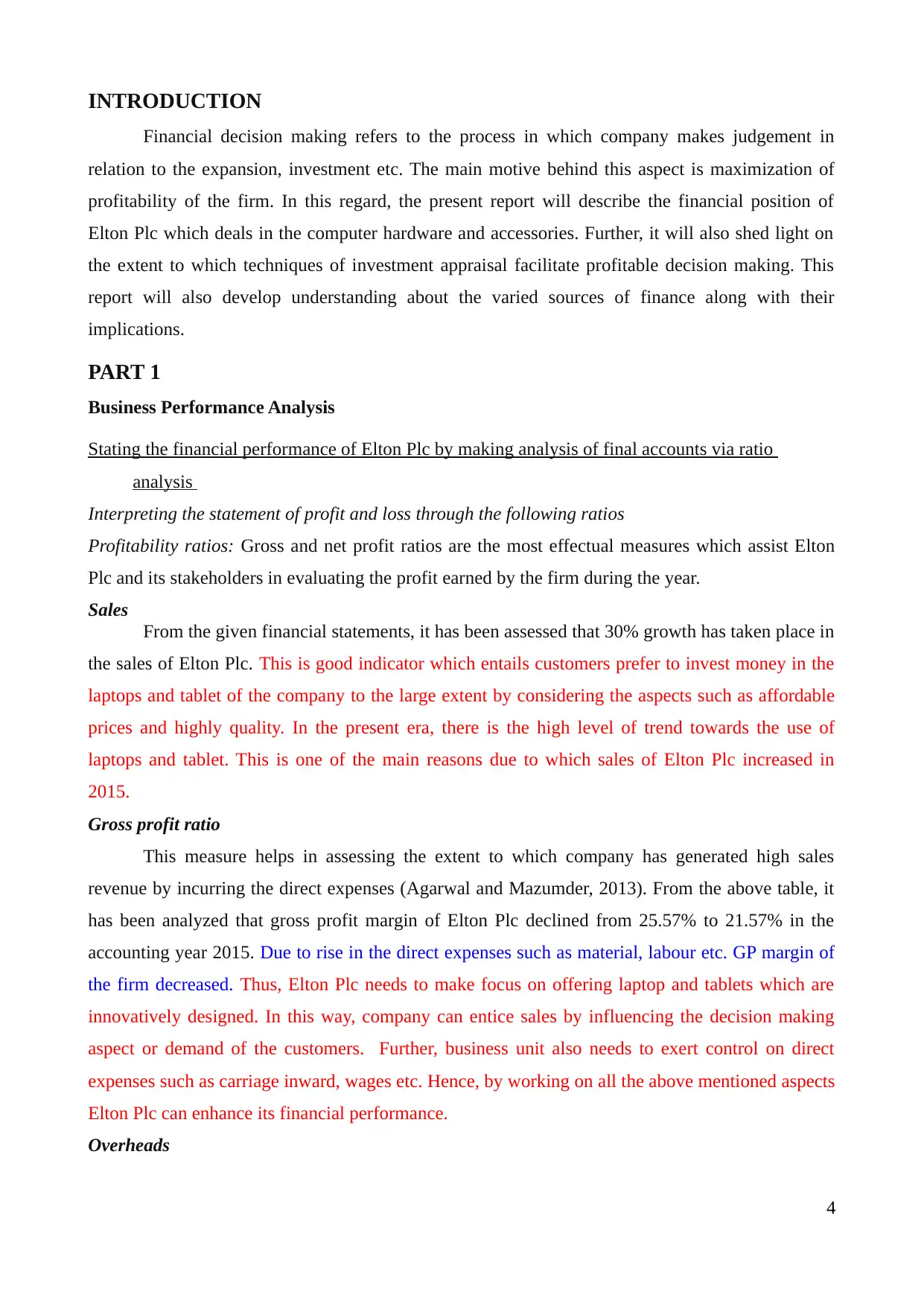
INTRODUCTION
Financial decision making refers to the process in which company makes judgement in
relation to the expansion, investment etc. The main motive behind this aspect is maximization of
profitability of the firm. In this regard, the present report will describe the financial position of
Elton Plc which deals in the computer hardware and accessories. Further, it will also shed light on
the extent to which techniques of investment appraisal facilitate profitable decision making. This
report will also develop understanding about the varied sources of finance along with their
implications.
PART 1
Business Performance Analysis
Stating the financial performance of Elton Plc by making analysis of final accounts via ratio
analysis
Interpreting the statement of profit and loss through the following ratios
Profitability ratios: Gross and net profit ratios are the most effectual measures which assist Elton
Plc and its stakeholders in evaluating the profit earned by the firm during the year.
Sales
From the given financial statements, it has been assessed that 30% growth has taken place in
the sales of Elton Plc. This is good indicator which entails customers prefer to invest money in the
laptops and tablet of the company to the large extent by considering the aspects such as affordable
prices and highly quality. In the present era, there is the high level of trend towards the use of
laptops and tablet. This is one of the main reasons due to which sales of Elton Plc increased in
2015.
Gross profit ratio
This measure helps in assessing the extent to which company has generated high sales
revenue by incurring the direct expenses (Agarwal and Mazumder, 2013). From the above table, it
has been analyzed that gross profit margin of Elton Plc declined from 25.57% to 21.57% in the
accounting year 2015. Due to rise in the direct expenses such as material, labour etc. GP margin of
the firm decreased. Thus, Elton Plc needs to make focus on offering laptop and tablets which are
innovatively designed. In this way, company can entice sales by influencing the decision making
aspect or demand of the customers. Further, business unit also needs to exert control on direct
expenses such as carriage inward, wages etc. Hence, by working on all the above mentioned aspects
Elton Plc can enhance its financial performance.
Overheads
4
Financial decision making refers to the process in which company makes judgement in
relation to the expansion, investment etc. The main motive behind this aspect is maximization of
profitability of the firm. In this regard, the present report will describe the financial position of
Elton Plc which deals in the computer hardware and accessories. Further, it will also shed light on
the extent to which techniques of investment appraisal facilitate profitable decision making. This
report will also develop understanding about the varied sources of finance along with their
implications.
PART 1
Business Performance Analysis
Stating the financial performance of Elton Plc by making analysis of final accounts via ratio
analysis
Interpreting the statement of profit and loss through the following ratios
Profitability ratios: Gross and net profit ratios are the most effectual measures which assist Elton
Plc and its stakeholders in evaluating the profit earned by the firm during the year.
Sales
From the given financial statements, it has been assessed that 30% growth has taken place in
the sales of Elton Plc. This is good indicator which entails customers prefer to invest money in the
laptops and tablet of the company to the large extent by considering the aspects such as affordable
prices and highly quality. In the present era, there is the high level of trend towards the use of
laptops and tablet. This is one of the main reasons due to which sales of Elton Plc increased in
2015.
Gross profit ratio
This measure helps in assessing the extent to which company has generated high sales
revenue by incurring the direct expenses (Agarwal and Mazumder, 2013). From the above table, it
has been analyzed that gross profit margin of Elton Plc declined from 25.57% to 21.57% in the
accounting year 2015. Due to rise in the direct expenses such as material, labour etc. GP margin of
the firm decreased. Thus, Elton Plc needs to make focus on offering laptop and tablets which are
innovatively designed. In this way, company can entice sales by influencing the decision making
aspect or demand of the customers. Further, business unit also needs to exert control on direct
expenses such as carriage inward, wages etc. Hence, by working on all the above mentioned aspects
Elton Plc can enhance its financial performance.
Overheads
4
Secure Best Marks with AI Grader
Need help grading? Try our AI Grader for instant feedback on your assignments.
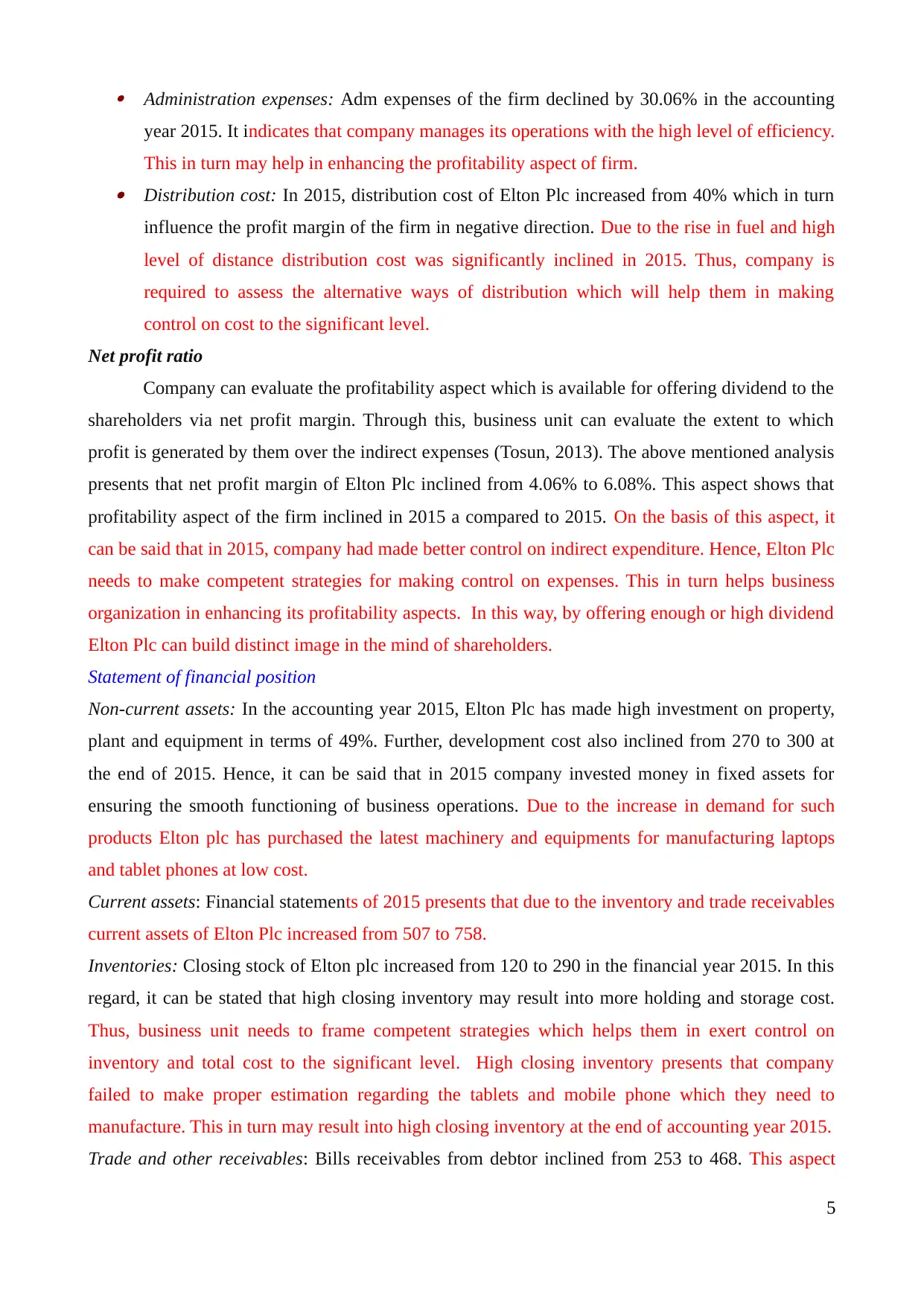
Administration expenses: Adm expenses of the firm declined by 30.06% in the accounting
year 2015. It indicates that company manages its operations with the high level of efficiency.
This in turn may help in enhancing the profitability aspect of firm. Distribution cost: In 2015, distribution cost of Elton Plc increased from 40% which in turn
influence the profit margin of the firm in negative direction. Due to the rise in fuel and high
level of distance distribution cost was significantly inclined in 2015. Thus, company is
required to assess the alternative ways of distribution which will help them in making
control on cost to the significant level.
Net profit ratio
Company can evaluate the profitability aspect which is available for offering dividend to the
shareholders via net profit margin. Through this, business unit can evaluate the extent to which
profit is generated by them over the indirect expenses (Tosun, 2013). The above mentioned analysis
presents that net profit margin of Elton Plc inclined from 4.06% to 6.08%. This aspect shows that
profitability aspect of the firm inclined in 2015 a compared to 2015. On the basis of this aspect, it
can be said that in 2015, company had made better control on indirect expenditure. Hence, Elton Plc
needs to make competent strategies for making control on expenses. This in turn helps business
organization in enhancing its profitability aspects. In this way, by offering enough or high dividend
Elton Plc can build distinct image in the mind of shareholders.
Statement of financial position
Non-current assets: In the accounting year 2015, Elton Plc has made high investment on property,
plant and equipment in terms of 49%. Further, development cost also inclined from 270 to 300 at
the end of 2015. Hence, it can be said that in 2015 company invested money in fixed assets for
ensuring the smooth functioning of business operations. Due to the increase in demand for such
products Elton plc has purchased the latest machinery and equipments for manufacturing laptops
and tablet phones at low cost.
Current assets: Financial statements of 2015 presents that due to the inventory and trade receivables
current assets of Elton Plc increased from 507 to 758.
Inventories: Closing stock of Elton plc increased from 120 to 290 in the financial year 2015. In this
regard, it can be stated that high closing inventory may result into more holding and storage cost.
Thus, business unit needs to frame competent strategies which helps them in exert control on
inventory and total cost to the significant level. High closing inventory presents that company
failed to make proper estimation regarding the tablets and mobile phone which they need to
manufacture. This in turn may result into high closing inventory at the end of accounting year 2015.
Trade and other receivables: Bills receivables from debtor inclined from 253 to 468. This aspect
5
year 2015. It indicates that company manages its operations with the high level of efficiency.
This in turn may help in enhancing the profitability aspect of firm. Distribution cost: In 2015, distribution cost of Elton Plc increased from 40% which in turn
influence the profit margin of the firm in negative direction. Due to the rise in fuel and high
level of distance distribution cost was significantly inclined in 2015. Thus, company is
required to assess the alternative ways of distribution which will help them in making
control on cost to the significant level.
Net profit ratio
Company can evaluate the profitability aspect which is available for offering dividend to the
shareholders via net profit margin. Through this, business unit can evaluate the extent to which
profit is generated by them over the indirect expenses (Tosun, 2013). The above mentioned analysis
presents that net profit margin of Elton Plc inclined from 4.06% to 6.08%. This aspect shows that
profitability aspect of the firm inclined in 2015 a compared to 2015. On the basis of this aspect, it
can be said that in 2015, company had made better control on indirect expenditure. Hence, Elton Plc
needs to make competent strategies for making control on expenses. This in turn helps business
organization in enhancing its profitability aspects. In this way, by offering enough or high dividend
Elton Plc can build distinct image in the mind of shareholders.
Statement of financial position
Non-current assets: In the accounting year 2015, Elton Plc has made high investment on property,
plant and equipment in terms of 49%. Further, development cost also inclined from 270 to 300 at
the end of 2015. Hence, it can be said that in 2015 company invested money in fixed assets for
ensuring the smooth functioning of business operations. Due to the increase in demand for such
products Elton plc has purchased the latest machinery and equipments for manufacturing laptops
and tablet phones at low cost.
Current assets: Financial statements of 2015 presents that due to the inventory and trade receivables
current assets of Elton Plc increased from 507 to 758.
Inventories: Closing stock of Elton plc increased from 120 to 290 in the financial year 2015. In this
regard, it can be stated that high closing inventory may result into more holding and storage cost.
Thus, business unit needs to frame competent strategies which helps them in exert control on
inventory and total cost to the significant level. High closing inventory presents that company
failed to make proper estimation regarding the tablets and mobile phone which they need to
manufacture. This in turn may result into high closing inventory at the end of accounting year 2015.
Trade and other receivables: Bills receivables from debtor inclined from 253 to 468. This aspect
5
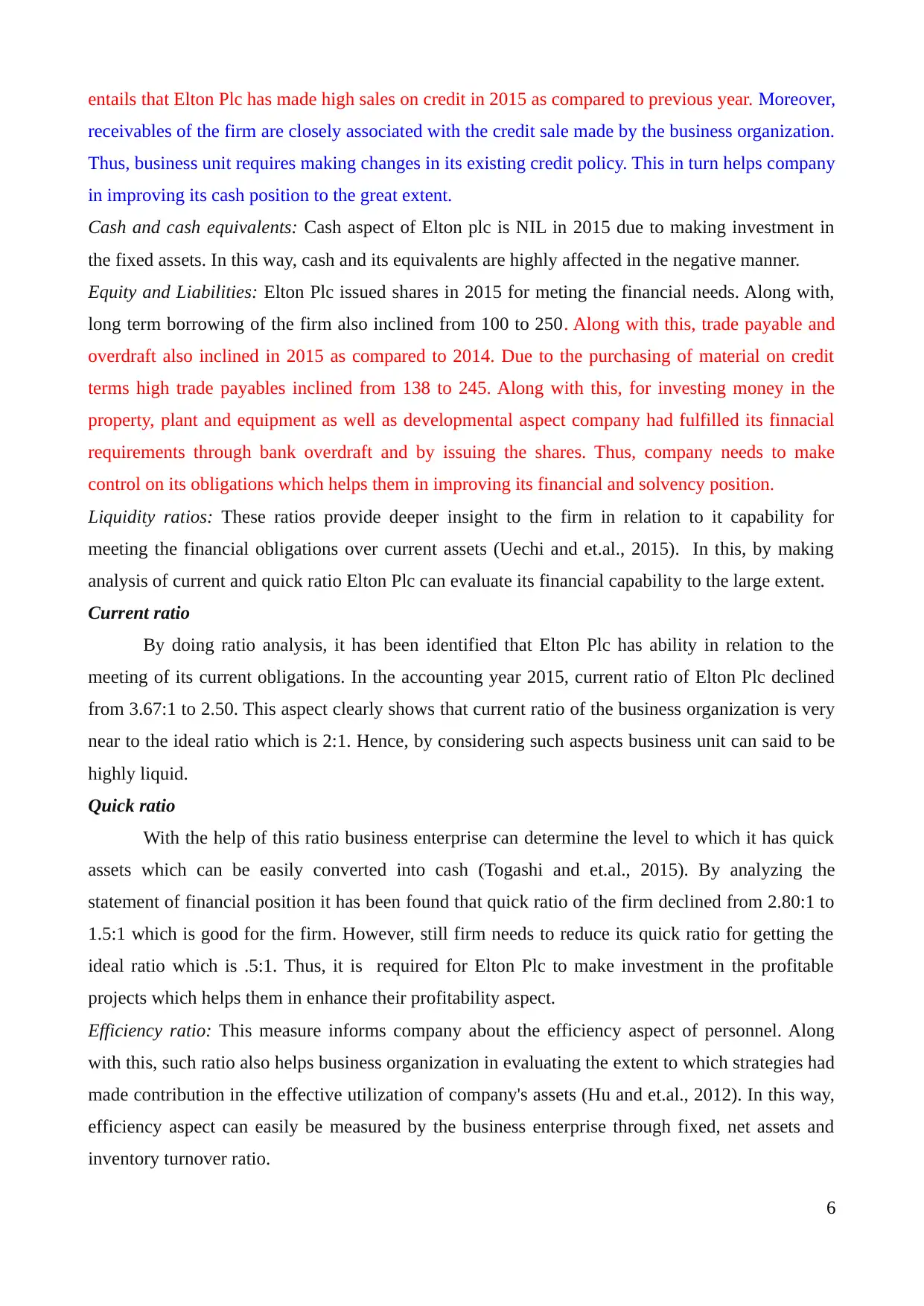
entails that Elton Plc has made high sales on credit in 2015 as compared to previous year. Moreover,
receivables of the firm are closely associated with the credit sale made by the business organization.
Thus, business unit requires making changes in its existing credit policy. This in turn helps company
in improving its cash position to the great extent.
Cash and cash equivalents: Cash aspect of Elton plc is NIL in 2015 due to making investment in
the fixed assets. In this way, cash and its equivalents are highly affected in the negative manner.
Equity and Liabilities: Elton Plc issued shares in 2015 for meting the financial needs. Along with,
long term borrowing of the firm also inclined from 100 to 250. Along with this, trade payable and
overdraft also inclined in 2015 as compared to 2014. Due to the purchasing of material on credit
terms high trade payables inclined from 138 to 245. Along with this, for investing money in the
property, plant and equipment as well as developmental aspect company had fulfilled its finnacial
requirements through bank overdraft and by issuing the shares. Thus, company needs to make
control on its obligations which helps them in improving its financial and solvency position.
Liquidity ratios: These ratios provide deeper insight to the firm in relation to it capability for
meeting the financial obligations over current assets (Uechi and et.al., 2015). In this, by making
analysis of current and quick ratio Elton Plc can evaluate its financial capability to the large extent.
Current ratio
By doing ratio analysis, it has been identified that Elton Plc has ability in relation to the
meeting of its current obligations. In the accounting year 2015, current ratio of Elton Plc declined
from 3.67:1 to 2.50. This aspect clearly shows that current ratio of the business organization is very
near to the ideal ratio which is 2:1. Hence, by considering such aspects business unit can said to be
highly liquid.
Quick ratio
With the help of this ratio business enterprise can determine the level to which it has quick
assets which can be easily converted into cash (Togashi and et.al., 2015). By analyzing the
statement of financial position it has been found that quick ratio of the firm declined from 2.80:1 to
1.5:1 which is good for the firm. However, still firm needs to reduce its quick ratio for getting the
ideal ratio which is .5:1. Thus, it is required for Elton Plc to make investment in the profitable
projects which helps them in enhance their profitability aspect.
Efficiency ratio: This measure informs company about the efficiency aspect of personnel. Along
with this, such ratio also helps business organization in evaluating the extent to which strategies had
made contribution in the effective utilization of company's assets (Hu and et.al., 2012). In this way,
efficiency aspect can easily be measured by the business enterprise through fixed, net assets and
inventory turnover ratio.
6
receivables of the firm are closely associated with the credit sale made by the business organization.
Thus, business unit requires making changes in its existing credit policy. This in turn helps company
in improving its cash position to the great extent.
Cash and cash equivalents: Cash aspect of Elton plc is NIL in 2015 due to making investment in
the fixed assets. In this way, cash and its equivalents are highly affected in the negative manner.
Equity and Liabilities: Elton Plc issued shares in 2015 for meting the financial needs. Along with,
long term borrowing of the firm also inclined from 100 to 250. Along with this, trade payable and
overdraft also inclined in 2015 as compared to 2014. Due to the purchasing of material on credit
terms high trade payables inclined from 138 to 245. Along with this, for investing money in the
property, plant and equipment as well as developmental aspect company had fulfilled its finnacial
requirements through bank overdraft and by issuing the shares. Thus, company needs to make
control on its obligations which helps them in improving its financial and solvency position.
Liquidity ratios: These ratios provide deeper insight to the firm in relation to it capability for
meeting the financial obligations over current assets (Uechi and et.al., 2015). In this, by making
analysis of current and quick ratio Elton Plc can evaluate its financial capability to the large extent.
Current ratio
By doing ratio analysis, it has been identified that Elton Plc has ability in relation to the
meeting of its current obligations. In the accounting year 2015, current ratio of Elton Plc declined
from 3.67:1 to 2.50. This aspect clearly shows that current ratio of the business organization is very
near to the ideal ratio which is 2:1. Hence, by considering such aspects business unit can said to be
highly liquid.
Quick ratio
With the help of this ratio business enterprise can determine the level to which it has quick
assets which can be easily converted into cash (Togashi and et.al., 2015). By analyzing the
statement of financial position it has been found that quick ratio of the firm declined from 2.80:1 to
1.5:1 which is good for the firm. However, still firm needs to reduce its quick ratio for getting the
ideal ratio which is .5:1. Thus, it is required for Elton Plc to make investment in the profitable
projects which helps them in enhance their profitability aspect.
Efficiency ratio: This measure informs company about the efficiency aspect of personnel. Along
with this, such ratio also helps business organization in evaluating the extent to which strategies had
made contribution in the effective utilization of company's assets (Hu and et.al., 2012). In this way,
efficiency aspect can easily be measured by the business enterprise through fixed, net assets and
inventory turnover ratio.
6
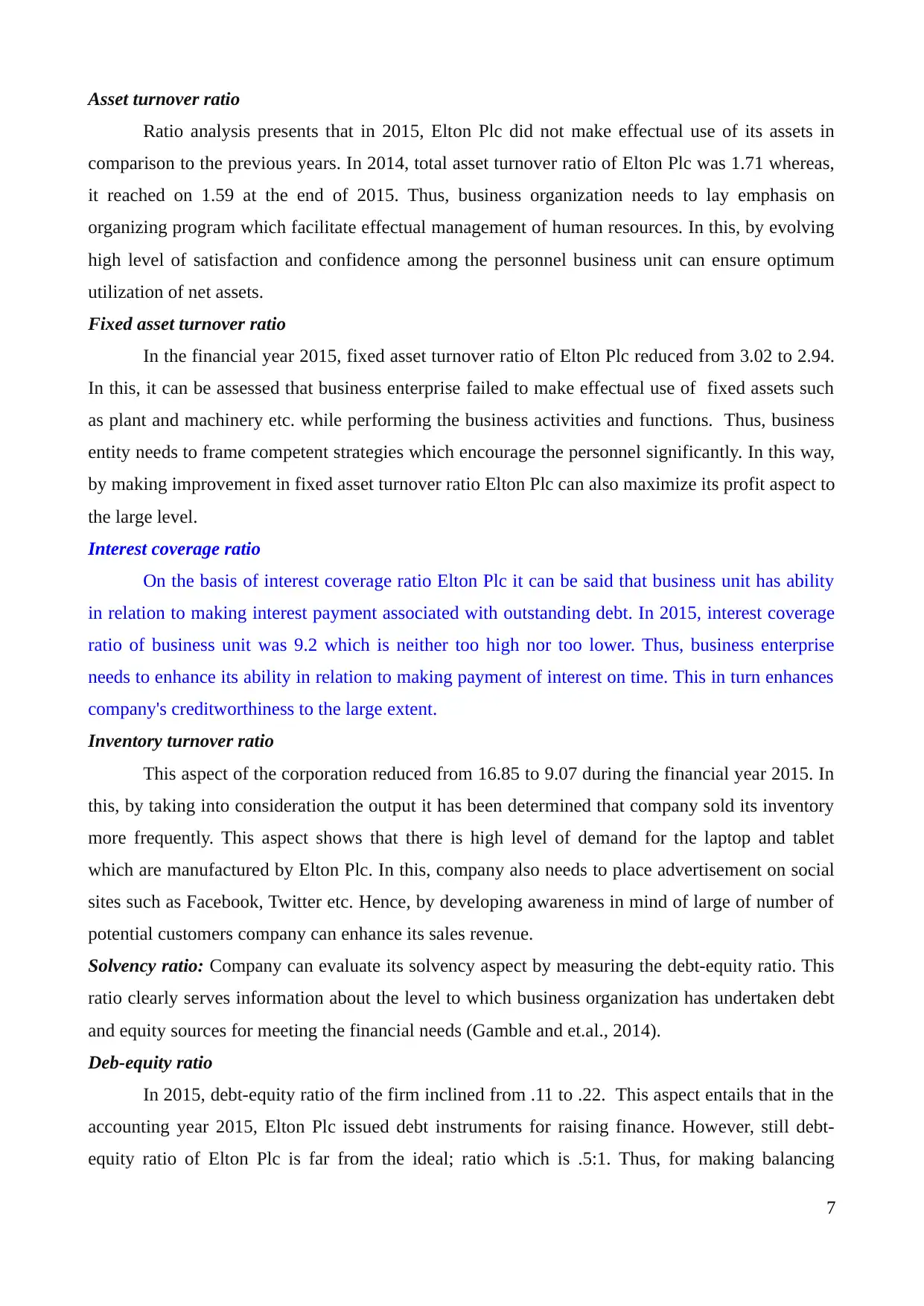
Asset turnover ratio
Ratio analysis presents that in 2015, Elton Plc did not make effectual use of its assets in
comparison to the previous years. In 2014, total asset turnover ratio of Elton Plc was 1.71 whereas,
it reached on 1.59 at the end of 2015. Thus, business organization needs to lay emphasis on
organizing program which facilitate effectual management of human resources. In this, by evolving
high level of satisfaction and confidence among the personnel business unit can ensure optimum
utilization of net assets.
Fixed asset turnover ratio
In the financial year 2015, fixed asset turnover ratio of Elton Plc reduced from 3.02 to 2.94.
In this, it can be assessed that business enterprise failed to make effectual use of fixed assets such
as plant and machinery etc. while performing the business activities and functions. Thus, business
entity needs to frame competent strategies which encourage the personnel significantly. In this way,
by making improvement in fixed asset turnover ratio Elton Plc can also maximize its profit aspect to
the large level.
Interest coverage ratio
On the basis of interest coverage ratio Elton Plc it can be said that business unit has ability
in relation to making interest payment associated with outstanding debt. In 2015, interest coverage
ratio of business unit was 9.2 which is neither too high nor too lower. Thus, business enterprise
needs to enhance its ability in relation to making payment of interest on time. This in turn enhances
company's creditworthiness to the large extent.
Inventory turnover ratio
This aspect of the corporation reduced from 16.85 to 9.07 during the financial year 2015. In
this, by taking into consideration the output it has been determined that company sold its inventory
more frequently. This aspect shows that there is high level of demand for the laptop and tablet
which are manufactured by Elton Plc. In this, company also needs to place advertisement on social
sites such as Facebook, Twitter etc. Hence, by developing awareness in mind of large of number of
potential customers company can enhance its sales revenue.
Solvency ratio: Company can evaluate its solvency aspect by measuring the debt-equity ratio. This
ratio clearly serves information about the level to which business organization has undertaken debt
and equity sources for meeting the financial needs (Gamble and et.al., 2014).
Deb-equity ratio
In 2015, debt-equity ratio of the firm inclined from .11 to .22. This aspect entails that in the
accounting year 2015, Elton Plc issued debt instruments for raising finance. However, still debt-
equity ratio of Elton Plc is far from the ideal; ratio which is .5:1. Thus, for making balancing
7
Ratio analysis presents that in 2015, Elton Plc did not make effectual use of its assets in
comparison to the previous years. In 2014, total asset turnover ratio of Elton Plc was 1.71 whereas,
it reached on 1.59 at the end of 2015. Thus, business organization needs to lay emphasis on
organizing program which facilitate effectual management of human resources. In this, by evolving
high level of satisfaction and confidence among the personnel business unit can ensure optimum
utilization of net assets.
Fixed asset turnover ratio
In the financial year 2015, fixed asset turnover ratio of Elton Plc reduced from 3.02 to 2.94.
In this, it can be assessed that business enterprise failed to make effectual use of fixed assets such
as plant and machinery etc. while performing the business activities and functions. Thus, business
entity needs to frame competent strategies which encourage the personnel significantly. In this way,
by making improvement in fixed asset turnover ratio Elton Plc can also maximize its profit aspect to
the large level.
Interest coverage ratio
On the basis of interest coverage ratio Elton Plc it can be said that business unit has ability
in relation to making interest payment associated with outstanding debt. In 2015, interest coverage
ratio of business unit was 9.2 which is neither too high nor too lower. Thus, business enterprise
needs to enhance its ability in relation to making payment of interest on time. This in turn enhances
company's creditworthiness to the large extent.
Inventory turnover ratio
This aspect of the corporation reduced from 16.85 to 9.07 during the financial year 2015. In
this, by taking into consideration the output it has been determined that company sold its inventory
more frequently. This aspect shows that there is high level of demand for the laptop and tablet
which are manufactured by Elton Plc. In this, company also needs to place advertisement on social
sites such as Facebook, Twitter etc. Hence, by developing awareness in mind of large of number of
potential customers company can enhance its sales revenue.
Solvency ratio: Company can evaluate its solvency aspect by measuring the debt-equity ratio. This
ratio clearly serves information about the level to which business organization has undertaken debt
and equity sources for meeting the financial needs (Gamble and et.al., 2014).
Deb-equity ratio
In 2015, debt-equity ratio of the firm inclined from .11 to .22. This aspect entails that in the
accounting year 2015, Elton Plc issued debt instruments for raising finance. However, still debt-
equity ratio of Elton Plc is far from the ideal; ratio which is .5:1. Thus, for making balancing
7
Paraphrase This Document
Need a fresh take? Get an instant paraphrase of this document with our AI Paraphraser
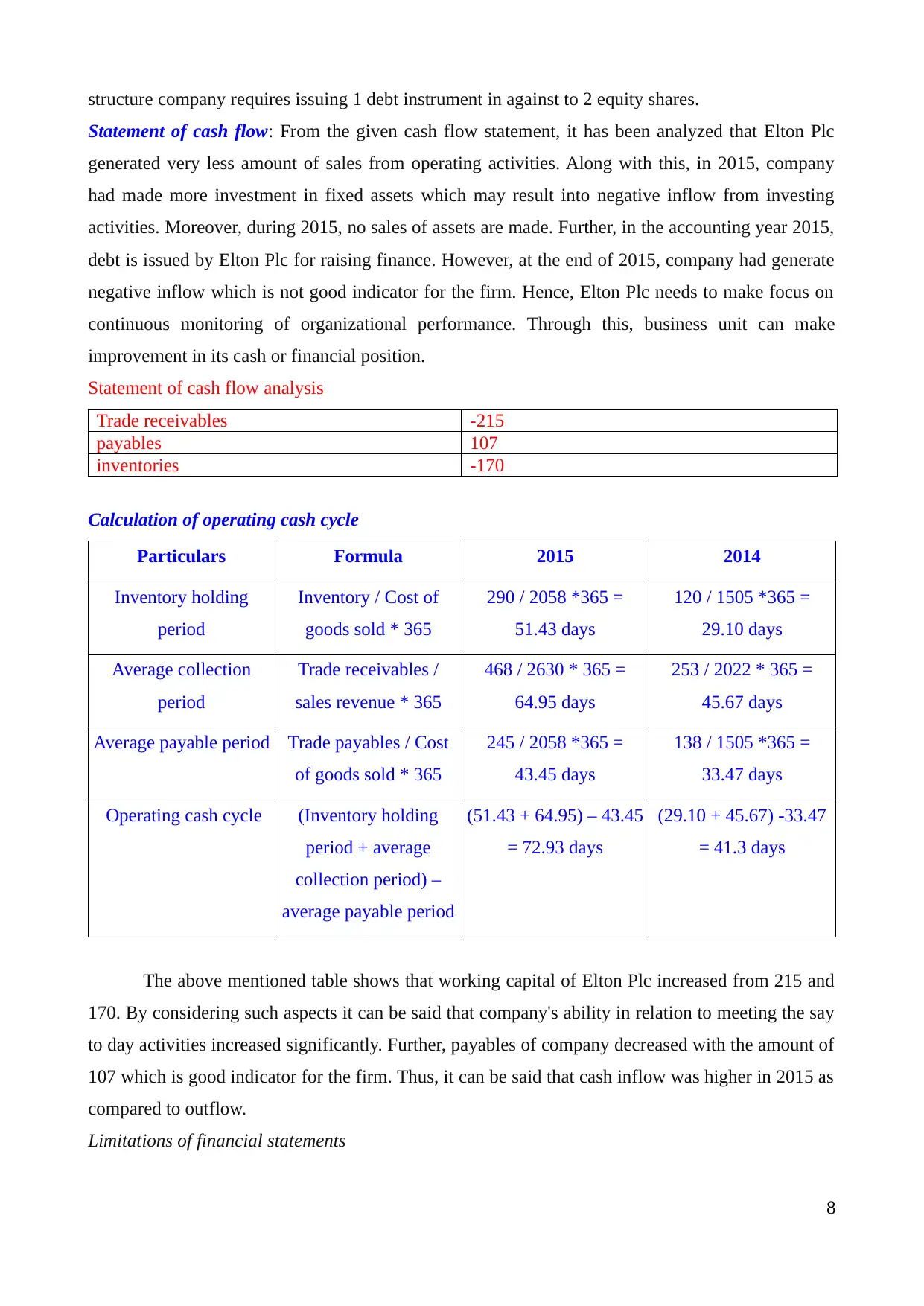
structure company requires issuing 1 debt instrument in against to 2 equity shares.
Statement of cash flow: From the given cash flow statement, it has been analyzed that Elton Plc
generated very less amount of sales from operating activities. Along with this, in 2015, company
had made more investment in fixed assets which may result into negative inflow from investing
activities. Moreover, during 2015, no sales of assets are made. Further, in the accounting year 2015,
debt is issued by Elton Plc for raising finance. However, at the end of 2015, company had generate
negative inflow which is not good indicator for the firm. Hence, Elton Plc needs to make focus on
continuous monitoring of organizational performance. Through this, business unit can make
improvement in its cash or financial position.
Statement of cash flow analysis
Trade receivables -215
payables 107
inventories -170
Calculation of operating cash cycle
Particulars Formula 2015 2014
Inventory holding
period
Inventory / Cost of
goods sold * 365
290 / 2058 *365 =
51.43 days
120 / 1505 *365 =
29.10 days
Average collection
period
Trade receivables /
sales revenue * 365
468 / 2630 * 365 =
64.95 days
253 / 2022 * 365 =
45.67 days
Average payable period Trade payables / Cost
of goods sold * 365
245 / 2058 *365 =
43.45 days
138 / 1505 *365 =
33.47 days
Operating cash cycle (Inventory holding
period + average
collection period) –
average payable period
(51.43 + 64.95) – 43.45
= 72.93 days
(29.10 + 45.67) -33.47
= 41.3 days
The above mentioned table shows that working capital of Elton Plc increased from 215 and
170. By considering such aspects it can be said that company's ability in relation to meeting the say
to day activities increased significantly. Further, payables of company decreased with the amount of
107 which is good indicator for the firm. Thus, it can be said that cash inflow was higher in 2015 as
compared to outflow.
Limitations of financial statements
8
Statement of cash flow: From the given cash flow statement, it has been analyzed that Elton Plc
generated very less amount of sales from operating activities. Along with this, in 2015, company
had made more investment in fixed assets which may result into negative inflow from investing
activities. Moreover, during 2015, no sales of assets are made. Further, in the accounting year 2015,
debt is issued by Elton Plc for raising finance. However, at the end of 2015, company had generate
negative inflow which is not good indicator for the firm. Hence, Elton Plc needs to make focus on
continuous monitoring of organizational performance. Through this, business unit can make
improvement in its cash or financial position.
Statement of cash flow analysis
Trade receivables -215
payables 107
inventories -170
Calculation of operating cash cycle
Particulars Formula 2015 2014
Inventory holding
period
Inventory / Cost of
goods sold * 365
290 / 2058 *365 =
51.43 days
120 / 1505 *365 =
29.10 days
Average collection
period
Trade receivables /
sales revenue * 365
468 / 2630 * 365 =
64.95 days
253 / 2022 * 365 =
45.67 days
Average payable period Trade payables / Cost
of goods sold * 365
245 / 2058 *365 =
43.45 days
138 / 1505 *365 =
33.47 days
Operating cash cycle (Inventory holding
period + average
collection period) –
average payable period
(51.43 + 64.95) – 43.45
= 72.93 days
(29.10 + 45.67) -33.47
= 41.3 days
The above mentioned table shows that working capital of Elton Plc increased from 215 and
170. By considering such aspects it can be said that company's ability in relation to meeting the say
to day activities increased significantly. Further, payables of company decreased with the amount of
107 which is good indicator for the firm. Thus, it can be said that cash inflow was higher in 2015 as
compared to outflow.
Limitations of financial statements
8
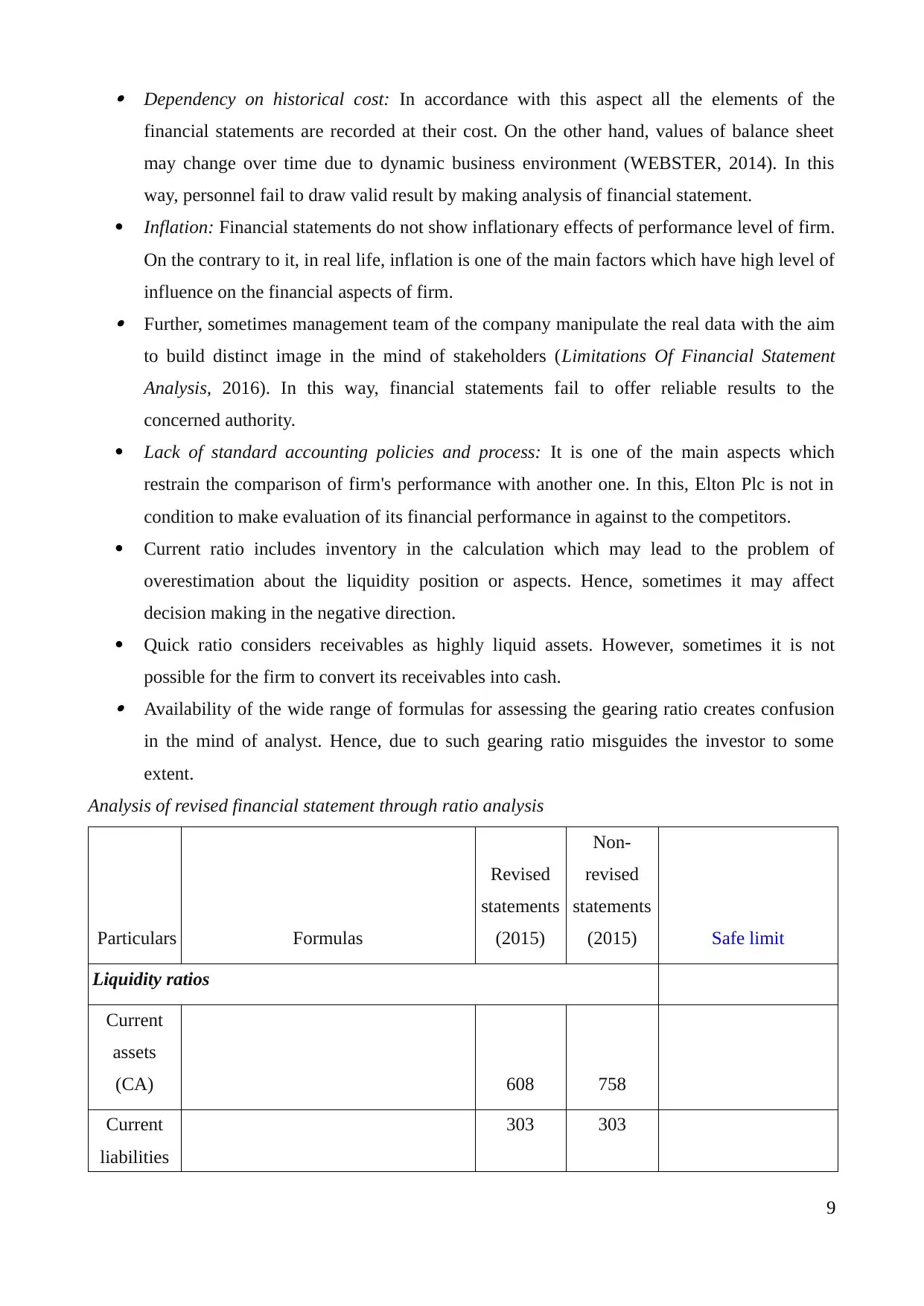
Dependency on historical cost: In accordance with this aspect all the elements of the
financial statements are recorded at their cost. On the other hand, values of balance sheet
may change over time due to dynamic business environment (WEBSTER, 2014). In this
way, personnel fail to draw valid result by making analysis of financial statement.
Inflation: Financial statements do not show inflationary effects of performance level of firm.
On the contrary to it, in real life, inflation is one of the main factors which have high level of
influence on the financial aspects of firm. Further, sometimes management team of the company manipulate the real data with the aim
to build distinct image in the mind of stakeholders (Limitations Of Financial Statement
Analysis, 2016). In this way, financial statements fail to offer reliable results to the
concerned authority.
Lack of standard accounting policies and process: It is one of the main aspects which
restrain the comparison of firm's performance with another one. In this, Elton Plc is not in
condition to make evaluation of its financial performance in against to the competitors.
Current ratio includes inventory in the calculation which may lead to the problem of
overestimation about the liquidity position or aspects. Hence, sometimes it may affect
decision making in the negative direction.
Quick ratio considers receivables as highly liquid assets. However, sometimes it is not
possible for the firm to convert its receivables into cash. Availability of the wide range of formulas for assessing the gearing ratio creates confusion
in the mind of analyst. Hence, due to such gearing ratio misguides the investor to some
extent.
Analysis of revised financial statement through ratio analysis
Particulars Formulas
Revised
statements
(2015)
Non-
revised
statements
(2015) Safe limit
Liquidity ratios
Current
assets
(CA) 608 758
Current
liabilities
303 303
9
financial statements are recorded at their cost. On the other hand, values of balance sheet
may change over time due to dynamic business environment (WEBSTER, 2014). In this
way, personnel fail to draw valid result by making analysis of financial statement.
Inflation: Financial statements do not show inflationary effects of performance level of firm.
On the contrary to it, in real life, inflation is one of the main factors which have high level of
influence on the financial aspects of firm. Further, sometimes management team of the company manipulate the real data with the aim
to build distinct image in the mind of stakeholders (Limitations Of Financial Statement
Analysis, 2016). In this way, financial statements fail to offer reliable results to the
concerned authority.
Lack of standard accounting policies and process: It is one of the main aspects which
restrain the comparison of firm's performance with another one. In this, Elton Plc is not in
condition to make evaluation of its financial performance in against to the competitors.
Current ratio includes inventory in the calculation which may lead to the problem of
overestimation about the liquidity position or aspects. Hence, sometimes it may affect
decision making in the negative direction.
Quick ratio considers receivables as highly liquid assets. However, sometimes it is not
possible for the firm to convert its receivables into cash. Availability of the wide range of formulas for assessing the gearing ratio creates confusion
in the mind of analyst. Hence, due to such gearing ratio misguides the investor to some
extent.
Analysis of revised financial statement through ratio analysis
Particulars Formulas
Revised
statements
(2015)
Non-
revised
statements
(2015) Safe limit
Liquidity ratios
Current
assets
(CA) 608 758
Current
liabilities
303 303
9
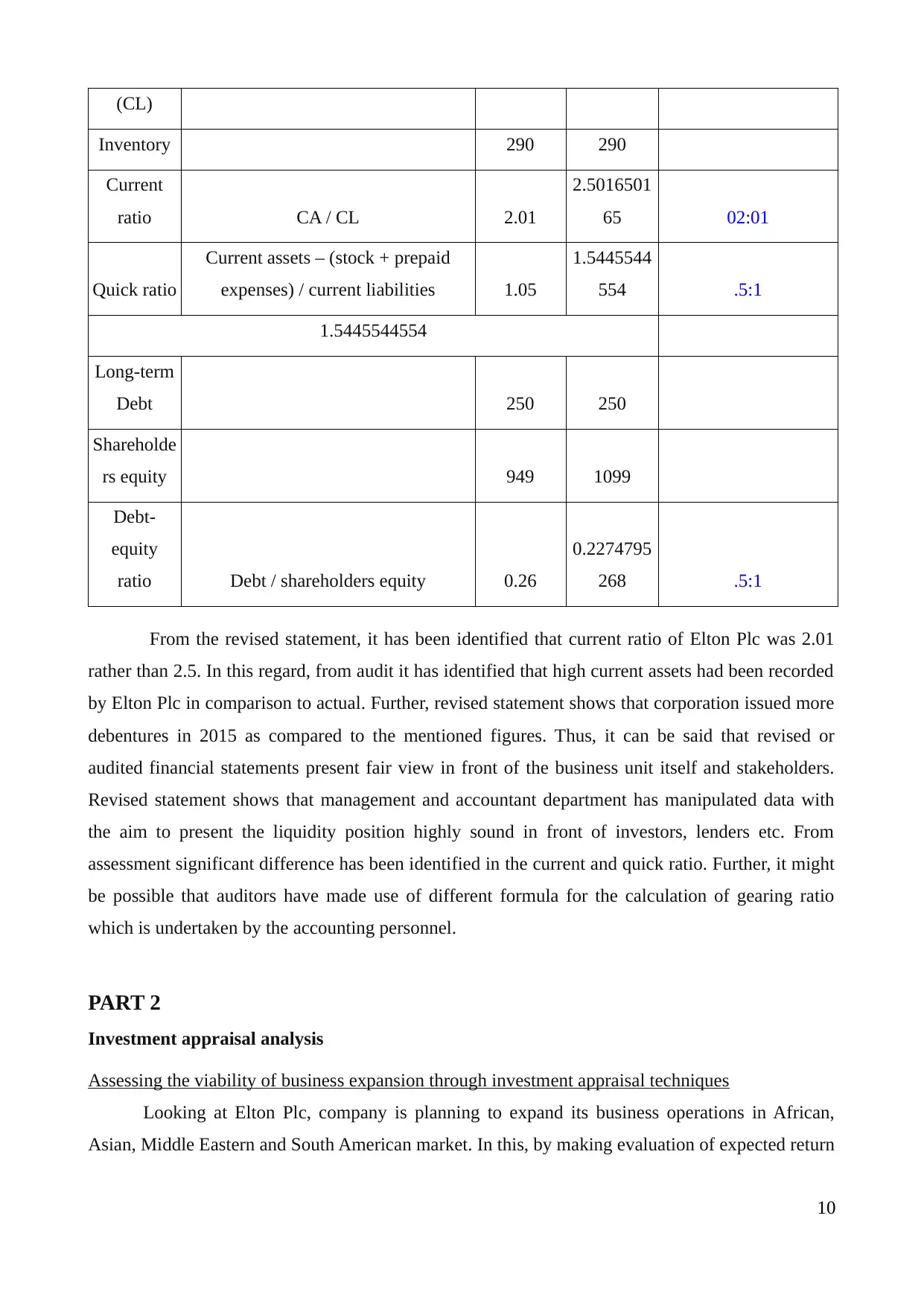
(CL)
Inventory 290 290
Current
ratio CA / CL 2.01
2.5016501
65 02:01
Quick ratio
Current assets – (stock + prepaid
expenses) / current liabilities 1.05
1.5445544
554 .5:1
1.5445544554
Long-term
Debt 250 250
Shareholde
rs equity 949 1099
Debt-
equity
ratio Debt / shareholders equity 0.26
0.2274795
268 .5:1
From the revised statement, it has been identified that current ratio of Elton Plc was 2.01
rather than 2.5. In this regard, from audit it has identified that high current assets had been recorded
by Elton Plc in comparison to actual. Further, revised statement shows that corporation issued more
debentures in 2015 as compared to the mentioned figures. Thus, it can be said that revised or
audited financial statements present fair view in front of the business unit itself and stakeholders.
Revised statement shows that management and accountant department has manipulated data with
the aim to present the liquidity position highly sound in front of investors, lenders etc. From
assessment significant difference has been identified in the current and quick ratio. Further, it might
be possible that auditors have made use of different formula for the calculation of gearing ratio
which is undertaken by the accounting personnel.
PART 2
Investment appraisal analysis
Assessing the viability of business expansion through investment appraisal techniques
Looking at Elton Plc, company is planning to expand its business operations in African,
Asian, Middle Eastern and South American market. In this, by making evaluation of expected return
10
Inventory 290 290
Current
ratio CA / CL 2.01
2.5016501
65 02:01
Quick ratio
Current assets – (stock + prepaid
expenses) / current liabilities 1.05
1.5445544
554 .5:1
1.5445544554
Long-term
Debt 250 250
Shareholde
rs equity 949 1099
Debt-
equity
ratio Debt / shareholders equity 0.26
0.2274795
268 .5:1
From the revised statement, it has been identified that current ratio of Elton Plc was 2.01
rather than 2.5. In this regard, from audit it has identified that high current assets had been recorded
by Elton Plc in comparison to actual. Further, revised statement shows that corporation issued more
debentures in 2015 as compared to the mentioned figures. Thus, it can be said that revised or
audited financial statements present fair view in front of the business unit itself and stakeholders.
Revised statement shows that management and accountant department has manipulated data with
the aim to present the liquidity position highly sound in front of investors, lenders etc. From
assessment significant difference has been identified in the current and quick ratio. Further, it might
be possible that auditors have made use of different formula for the calculation of gearing ratio
which is undertaken by the accounting personnel.
PART 2
Investment appraisal analysis
Assessing the viability of business expansion through investment appraisal techniques
Looking at Elton Plc, company is planning to expand its business operations in African,
Asian, Middle Eastern and South American market. In this, by making evaluation of expected return
10
Secure Best Marks with AI Grader
Need help grading? Try our AI Grader for instant feedback on your assignments.
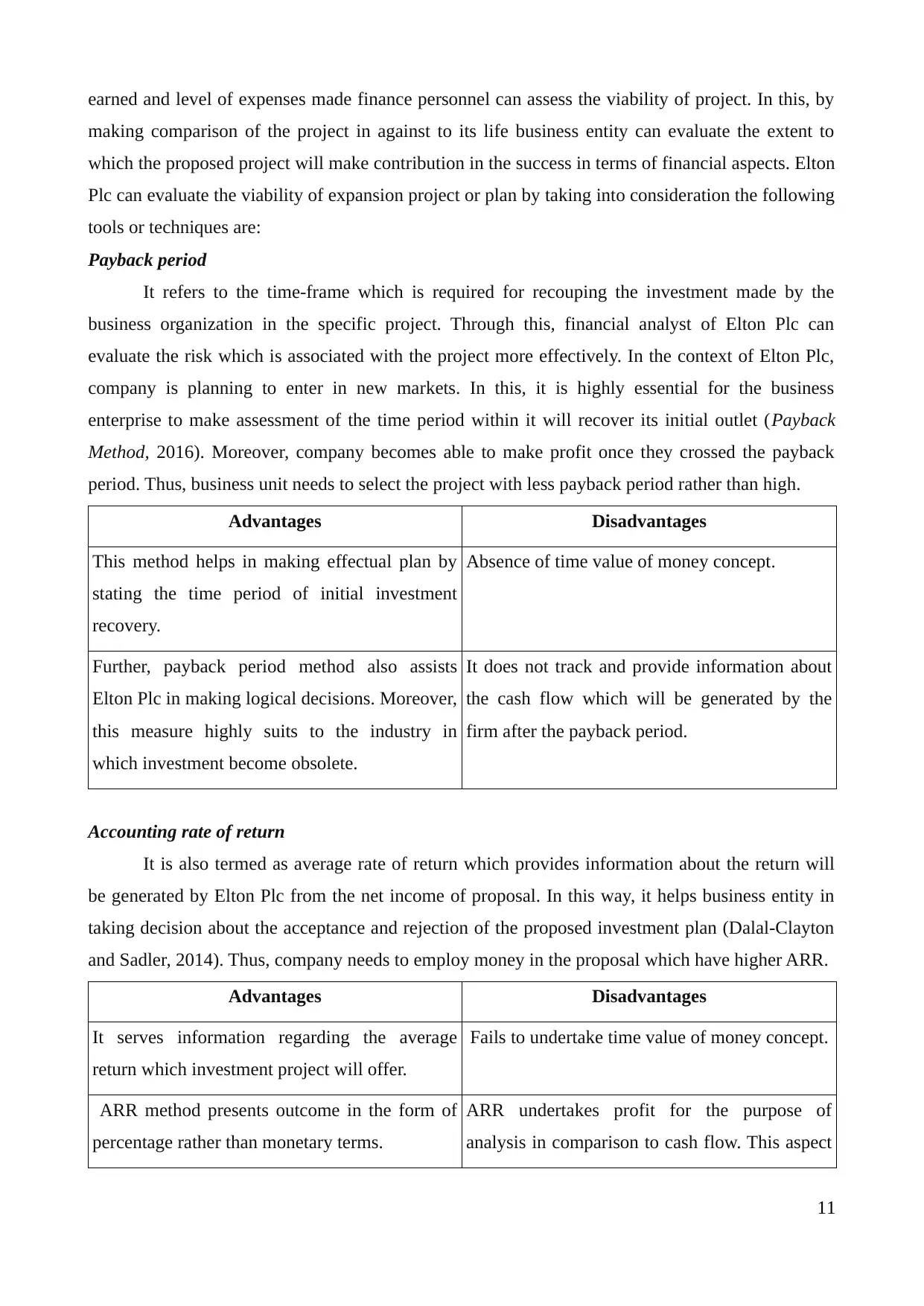
earned and level of expenses made finance personnel can assess the viability of project. In this, by
making comparison of the project in against to its life business entity can evaluate the extent to
which the proposed project will make contribution in the success in terms of financial aspects. Elton
Plc can evaluate the viability of expansion project or plan by taking into consideration the following
tools or techniques are:
Payback period
It refers to the time-frame which is required for recouping the investment made by the
business organization in the specific project. Through this, financial analyst of Elton Plc can
evaluate the risk which is associated with the project more effectively. In the context of Elton Plc,
company is planning to enter in new markets. In this, it is highly essential for the business
enterprise to make assessment of the time period within it will recover its initial outlet (Payback
Method, 2016). Moreover, company becomes able to make profit once they crossed the payback
period. Thus, business unit needs to select the project with less payback period rather than high.
Advantages Disadvantages
This method helps in making effectual plan by
stating the time period of initial investment
recovery.
Absence of time value of money concept.
Further, payback period method also assists
Elton Plc in making logical decisions. Moreover,
this measure highly suits to the industry in
which investment become obsolete.
It does not track and provide information about
the cash flow which will be generated by the
firm after the payback period.
Accounting rate of return
It is also termed as average rate of return which provides information about the return will
be generated by Elton Plc from the net income of proposal. In this way, it helps business entity in
taking decision about the acceptance and rejection of the proposed investment plan (Dalal-Clayton
and Sadler, 2014). Thus, company needs to employ money in the proposal which have higher ARR.
Advantages Disadvantages
It serves information regarding the average
return which investment project will offer.
Fails to undertake time value of money concept.
ARR method presents outcome in the form of
percentage rather than monetary terms.
ARR undertakes profit for the purpose of
analysis in comparison to cash flow. This aspect
11
making comparison of the project in against to its life business entity can evaluate the extent to
which the proposed project will make contribution in the success in terms of financial aspects. Elton
Plc can evaluate the viability of expansion project or plan by taking into consideration the following
tools or techniques are:
Payback period
It refers to the time-frame which is required for recouping the investment made by the
business organization in the specific project. Through this, financial analyst of Elton Plc can
evaluate the risk which is associated with the project more effectively. In the context of Elton Plc,
company is planning to enter in new markets. In this, it is highly essential for the business
enterprise to make assessment of the time period within it will recover its initial outlet (Payback
Method, 2016). Moreover, company becomes able to make profit once they crossed the payback
period. Thus, business unit needs to select the project with less payback period rather than high.
Advantages Disadvantages
This method helps in making effectual plan by
stating the time period of initial investment
recovery.
Absence of time value of money concept.
Further, payback period method also assists
Elton Plc in making logical decisions. Moreover,
this measure highly suits to the industry in
which investment become obsolete.
It does not track and provide information about
the cash flow which will be generated by the
firm after the payback period.
Accounting rate of return
It is also termed as average rate of return which provides information about the return will
be generated by Elton Plc from the net income of proposal. In this way, it helps business entity in
taking decision about the acceptance and rejection of the proposed investment plan (Dalal-Clayton
and Sadler, 2014). Thus, company needs to employ money in the proposal which have higher ARR.
Advantages Disadvantages
It serves information regarding the average
return which investment project will offer.
Fails to undertake time value of money concept.
ARR method presents outcome in the form of
percentage rather than monetary terms.
ARR undertakes profit for the purpose of
analysis in comparison to cash flow. This aspect
11
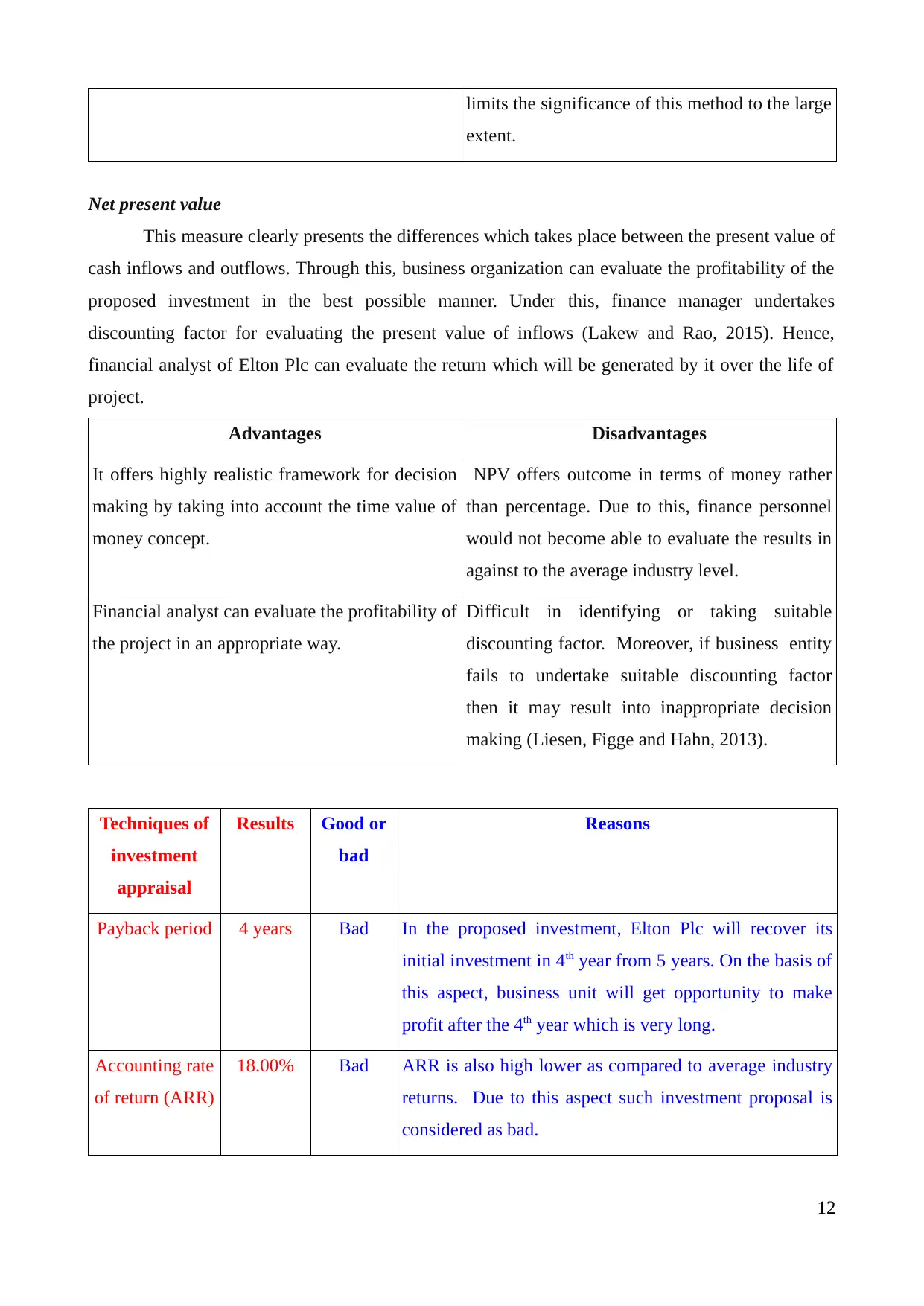
limits the significance of this method to the large
extent.
Net present value
This measure clearly presents the differences which takes place between the present value of
cash inflows and outflows. Through this, business organization can evaluate the profitability of the
proposed investment in the best possible manner. Under this, finance manager undertakes
discounting factor for evaluating the present value of inflows (Lakew and Rao, 2015). Hence,
financial analyst of Elton Plc can evaluate the return which will be generated by it over the life of
project.
Advantages Disadvantages
It offers highly realistic framework for decision
making by taking into account the time value of
money concept.
NPV offers outcome in terms of money rather
than percentage. Due to this, finance personnel
would not become able to evaluate the results in
against to the average industry level.
Financial analyst can evaluate the profitability of
the project in an appropriate way.
Difficult in identifying or taking suitable
discounting factor. Moreover, if business entity
fails to undertake suitable discounting factor
then it may result into inappropriate decision
making (Liesen, Figge and Hahn, 2013).
Techniques of
investment
appraisal
Results Good or
bad
Reasons
Payback period 4 years Bad In the proposed investment, Elton Plc will recover its
initial investment in 4th year from 5 years. On the basis of
this aspect, business unit will get opportunity to make
profit after the 4th year which is very long.
Accounting rate
of return (ARR)
18.00% Bad ARR is also high lower as compared to average industry
returns. Due to this aspect such investment proposal is
considered as bad.
12
extent.
Net present value
This measure clearly presents the differences which takes place between the present value of
cash inflows and outflows. Through this, business organization can evaluate the profitability of the
proposed investment in the best possible manner. Under this, finance manager undertakes
discounting factor for evaluating the present value of inflows (Lakew and Rao, 2015). Hence,
financial analyst of Elton Plc can evaluate the return which will be generated by it over the life of
project.
Advantages Disadvantages
It offers highly realistic framework for decision
making by taking into account the time value of
money concept.
NPV offers outcome in terms of money rather
than percentage. Due to this, finance personnel
would not become able to evaluate the results in
against to the average industry level.
Financial analyst can evaluate the profitability of
the project in an appropriate way.
Difficult in identifying or taking suitable
discounting factor. Moreover, if business entity
fails to undertake suitable discounting factor
then it may result into inappropriate decision
making (Liesen, Figge and Hahn, 2013).
Techniques of
investment
appraisal
Results Good or
bad
Reasons
Payback period 4 years Bad In the proposed investment, Elton Plc will recover its
initial investment in 4th year from 5 years. On the basis of
this aspect, business unit will get opportunity to make
profit after the 4th year which is very long.
Accounting rate
of return (ARR)
18.00% Bad ARR is also high lower as compared to average industry
returns. Due to this aspect such investment proposal is
considered as bad.
12
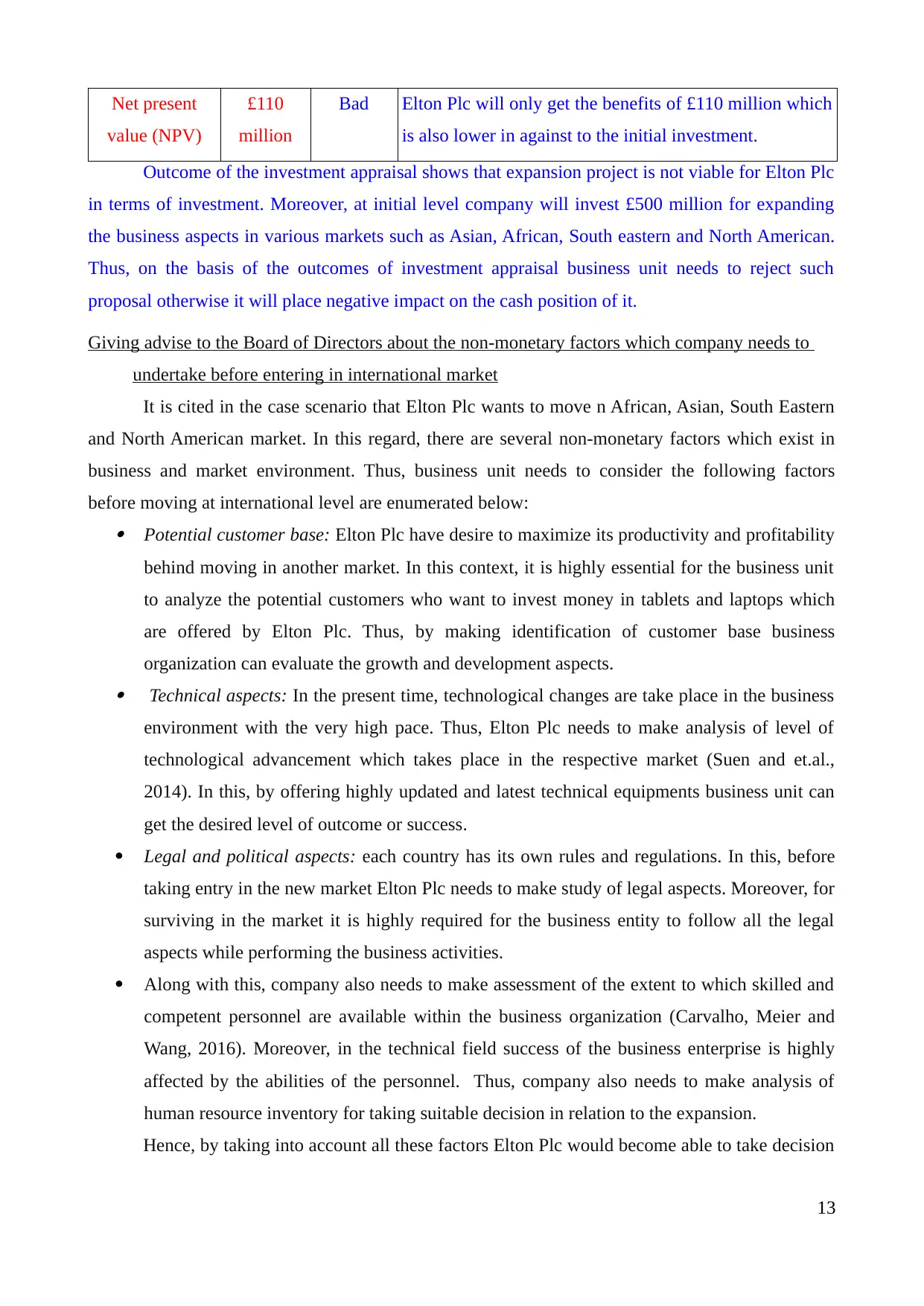
Net present
value (NPV)
£110
million
Bad Elton Plc will only get the benefits of £110 million which
is also lower in against to the initial investment.
Outcome of the investment appraisal shows that expansion project is not viable for Elton Plc
in terms of investment. Moreover, at initial level company will invest £500 million for expanding
the business aspects in various markets such as Asian, African, South eastern and North American.
Thus, on the basis of the outcomes of investment appraisal business unit needs to reject such
proposal otherwise it will place negative impact on the cash position of it.
Giving advise to the Board of Directors about the non-monetary factors which company needs to
undertake before entering in international market
It is cited in the case scenario that Elton Plc wants to move n African, Asian, South Eastern
and North American market. In this regard, there are several non-monetary factors which exist in
business and market environment. Thus, business unit needs to consider the following factors
before moving at international level are enumerated below: Potential customer base: Elton Plc have desire to maximize its productivity and profitability
behind moving in another market. In this context, it is highly essential for the business unit
to analyze the potential customers who want to invest money in tablets and laptops which
are offered by Elton Plc. Thus, by making identification of customer base business
organization can evaluate the growth and development aspects. Technical aspects: In the present time, technological changes are take place in the business
environment with the very high pace. Thus, Elton Plc needs to make analysis of level of
technological advancement which takes place in the respective market (Suen and et.al.,
2014). In this, by offering highly updated and latest technical equipments business unit can
get the desired level of outcome or success.
Legal and political aspects: each country has its own rules and regulations. In this, before
taking entry in the new market Elton Plc needs to make study of legal aspects. Moreover, for
surviving in the market it is highly required for the business entity to follow all the legal
aspects while performing the business activities.
Along with this, company also needs to make assessment of the extent to which skilled and
competent personnel are available within the business organization (Carvalho, Meier and
Wang, 2016). Moreover, in the technical field success of the business enterprise is highly
affected by the abilities of the personnel. Thus, company also needs to make analysis of
human resource inventory for taking suitable decision in relation to the expansion.
Hence, by taking into account all these factors Elton Plc would become able to take decision
13
value (NPV)
£110
million
Bad Elton Plc will only get the benefits of £110 million which
is also lower in against to the initial investment.
Outcome of the investment appraisal shows that expansion project is not viable for Elton Plc
in terms of investment. Moreover, at initial level company will invest £500 million for expanding
the business aspects in various markets such as Asian, African, South eastern and North American.
Thus, on the basis of the outcomes of investment appraisal business unit needs to reject such
proposal otherwise it will place negative impact on the cash position of it.
Giving advise to the Board of Directors about the non-monetary factors which company needs to
undertake before entering in international market
It is cited in the case scenario that Elton Plc wants to move n African, Asian, South Eastern
and North American market. In this regard, there are several non-monetary factors which exist in
business and market environment. Thus, business unit needs to consider the following factors
before moving at international level are enumerated below: Potential customer base: Elton Plc have desire to maximize its productivity and profitability
behind moving in another market. In this context, it is highly essential for the business unit
to analyze the potential customers who want to invest money in tablets and laptops which
are offered by Elton Plc. Thus, by making identification of customer base business
organization can evaluate the growth and development aspects. Technical aspects: In the present time, technological changes are take place in the business
environment with the very high pace. Thus, Elton Plc needs to make analysis of level of
technological advancement which takes place in the respective market (Suen and et.al.,
2014). In this, by offering highly updated and latest technical equipments business unit can
get the desired level of outcome or success.
Legal and political aspects: each country has its own rules and regulations. In this, before
taking entry in the new market Elton Plc needs to make study of legal aspects. Moreover, for
surviving in the market it is highly required for the business entity to follow all the legal
aspects while performing the business activities.
Along with this, company also needs to make assessment of the extent to which skilled and
competent personnel are available within the business organization (Carvalho, Meier and
Wang, 2016). Moreover, in the technical field success of the business enterprise is highly
affected by the abilities of the personnel. Thus, company also needs to make analysis of
human resource inventory for taking suitable decision in relation to the expansion.
Hence, by taking into account all these factors Elton Plc would become able to take decision
13
Paraphrase This Document
Need a fresh take? Get an instant paraphrase of this document with our AI Paraphraser
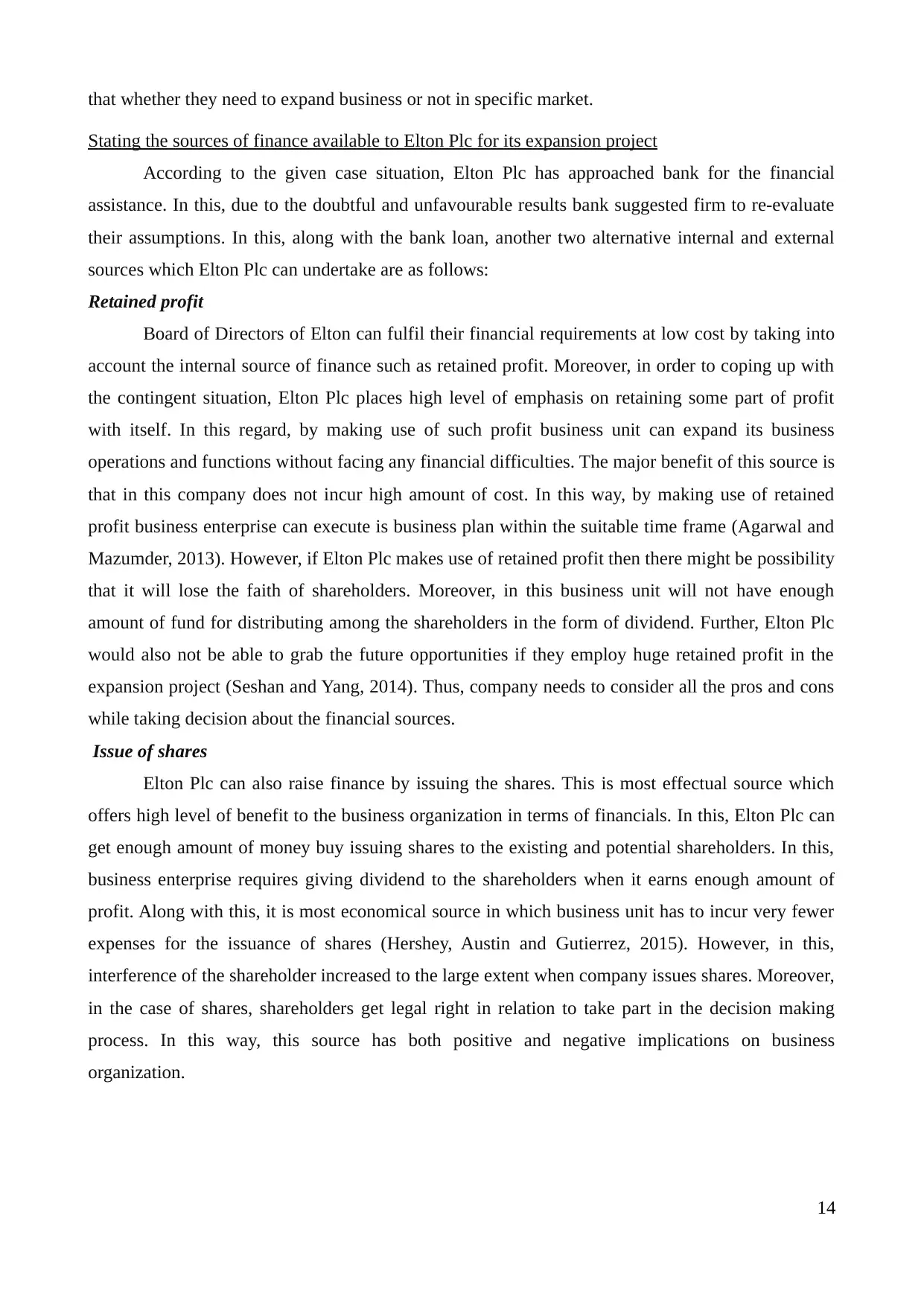
that whether they need to expand business or not in specific market.
Stating the sources of finance available to Elton Plc for its expansion project
According to the given case situation, Elton Plc has approached bank for the financial
assistance. In this, due to the doubtful and unfavourable results bank suggested firm to re-evaluate
their assumptions. In this, along with the bank loan, another two alternative internal and external
sources which Elton Plc can undertake are as follows:
Retained profit
Board of Directors of Elton can fulfil their financial requirements at low cost by taking into
account the internal source of finance such as retained profit. Moreover, in order to coping up with
the contingent situation, Elton Plc places high level of emphasis on retaining some part of profit
with itself. In this regard, by making use of such profit business unit can expand its business
operations and functions without facing any financial difficulties. The major benefit of this source is
that in this company does not incur high amount of cost. In this way, by making use of retained
profit business enterprise can execute is business plan within the suitable time frame (Agarwal and
Mazumder, 2013). However, if Elton Plc makes use of retained profit then there might be possibility
that it will lose the faith of shareholders. Moreover, in this business unit will not have enough
amount of fund for distributing among the shareholders in the form of dividend. Further, Elton Plc
would also not be able to grab the future opportunities if they employ huge retained profit in the
expansion project (Seshan and Yang, 2014). Thus, company needs to consider all the pros and cons
while taking decision about the financial sources.
Issue of shares
Elton Plc can also raise finance by issuing the shares. This is most effectual source which
offers high level of benefit to the business organization in terms of financials. In this, Elton Plc can
get enough amount of money buy issuing shares to the existing and potential shareholders. In this,
business enterprise requires giving dividend to the shareholders when it earns enough amount of
profit. Along with this, it is most economical source in which business unit has to incur very fewer
expenses for the issuance of shares (Hershey, Austin and Gutierrez, 2015). However, in this,
interference of the shareholder increased to the large extent when company issues shares. Moreover,
in the case of shares, shareholders get legal right in relation to take part in the decision making
process. In this way, this source has both positive and negative implications on business
organization.
14
Stating the sources of finance available to Elton Plc for its expansion project
According to the given case situation, Elton Plc has approached bank for the financial
assistance. In this, due to the doubtful and unfavourable results bank suggested firm to re-evaluate
their assumptions. In this, along with the bank loan, another two alternative internal and external
sources which Elton Plc can undertake are as follows:
Retained profit
Board of Directors of Elton can fulfil their financial requirements at low cost by taking into
account the internal source of finance such as retained profit. Moreover, in order to coping up with
the contingent situation, Elton Plc places high level of emphasis on retaining some part of profit
with itself. In this regard, by making use of such profit business unit can expand its business
operations and functions without facing any financial difficulties. The major benefit of this source is
that in this company does not incur high amount of cost. In this way, by making use of retained
profit business enterprise can execute is business plan within the suitable time frame (Agarwal and
Mazumder, 2013). However, if Elton Plc makes use of retained profit then there might be possibility
that it will lose the faith of shareholders. Moreover, in this business unit will not have enough
amount of fund for distributing among the shareholders in the form of dividend. Further, Elton Plc
would also not be able to grab the future opportunities if they employ huge retained profit in the
expansion project (Seshan and Yang, 2014). Thus, company needs to consider all the pros and cons
while taking decision about the financial sources.
Issue of shares
Elton Plc can also raise finance by issuing the shares. This is most effectual source which
offers high level of benefit to the business organization in terms of financials. In this, Elton Plc can
get enough amount of money buy issuing shares to the existing and potential shareholders. In this,
business enterprise requires giving dividend to the shareholders when it earns enough amount of
profit. Along with this, it is most economical source in which business unit has to incur very fewer
expenses for the issuance of shares (Hershey, Austin and Gutierrez, 2015). However, in this,
interference of the shareholder increased to the large extent when company issues shares. Moreover,
in the case of shares, shareholders get legal right in relation to take part in the decision making
process. In this way, this source has both positive and negative implications on business
organization.
14
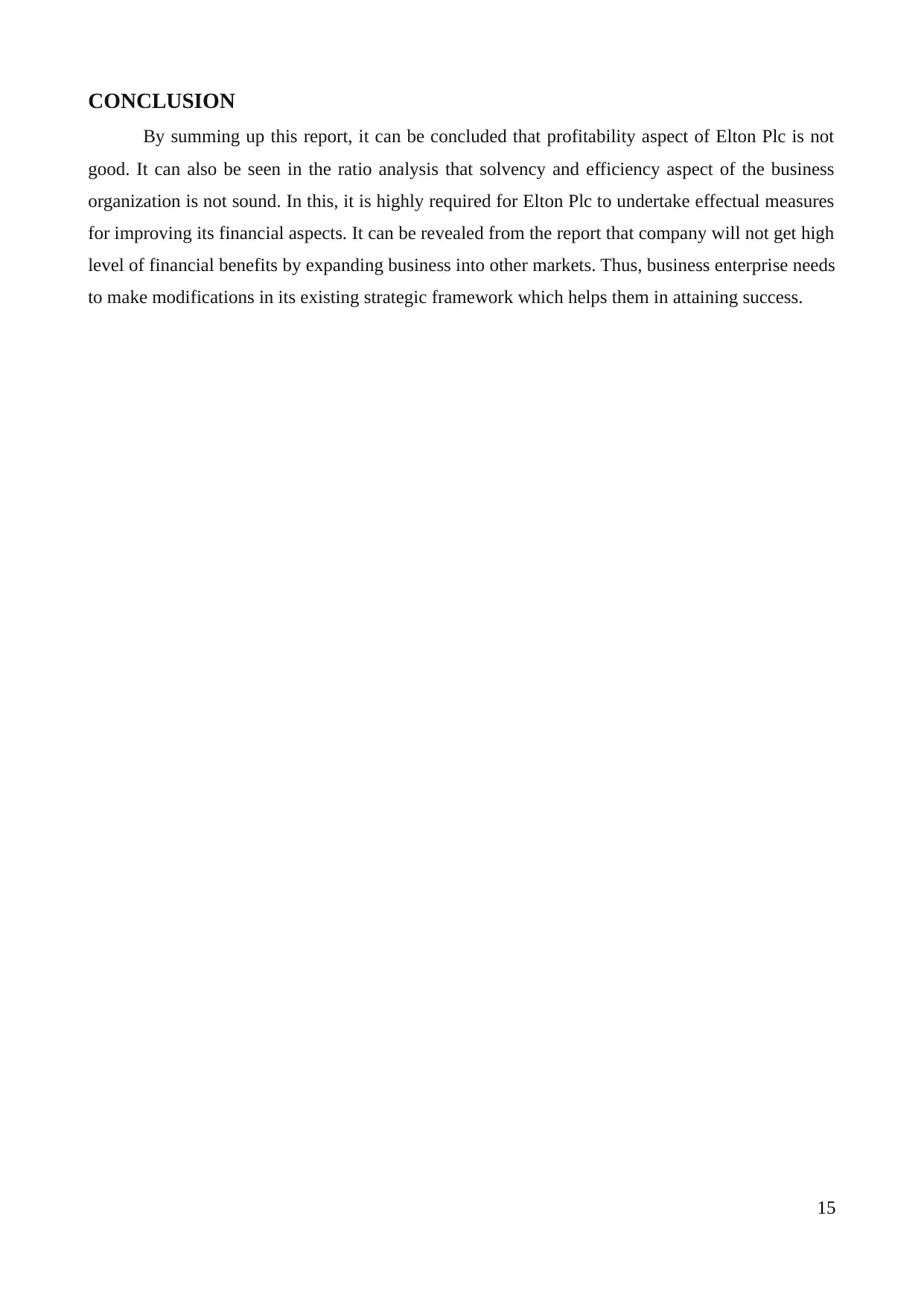
CONCLUSION
By summing up this report, it can be concluded that profitability aspect of Elton Plc is not
good. It can also be seen in the ratio analysis that solvency and efficiency aspect of the business
organization is not sound. In this, it is highly required for Elton Plc to undertake effectual measures
for improving its financial aspects. It can be revealed from the report that company will not get high
level of financial benefits by expanding business into other markets. Thus, business enterprise needs
to make modifications in its existing strategic framework which helps them in attaining success.
15
By summing up this report, it can be concluded that profitability aspect of Elton Plc is not
good. It can also be seen in the ratio analysis that solvency and efficiency aspect of the business
organization is not sound. In this, it is highly required for Elton Plc to undertake effectual measures
for improving its financial aspects. It can be revealed from the report that company will not get high
level of financial benefits by expanding business into other markets. Thus, business enterprise needs
to make modifications in its existing strategic framework which helps them in attaining success.
15
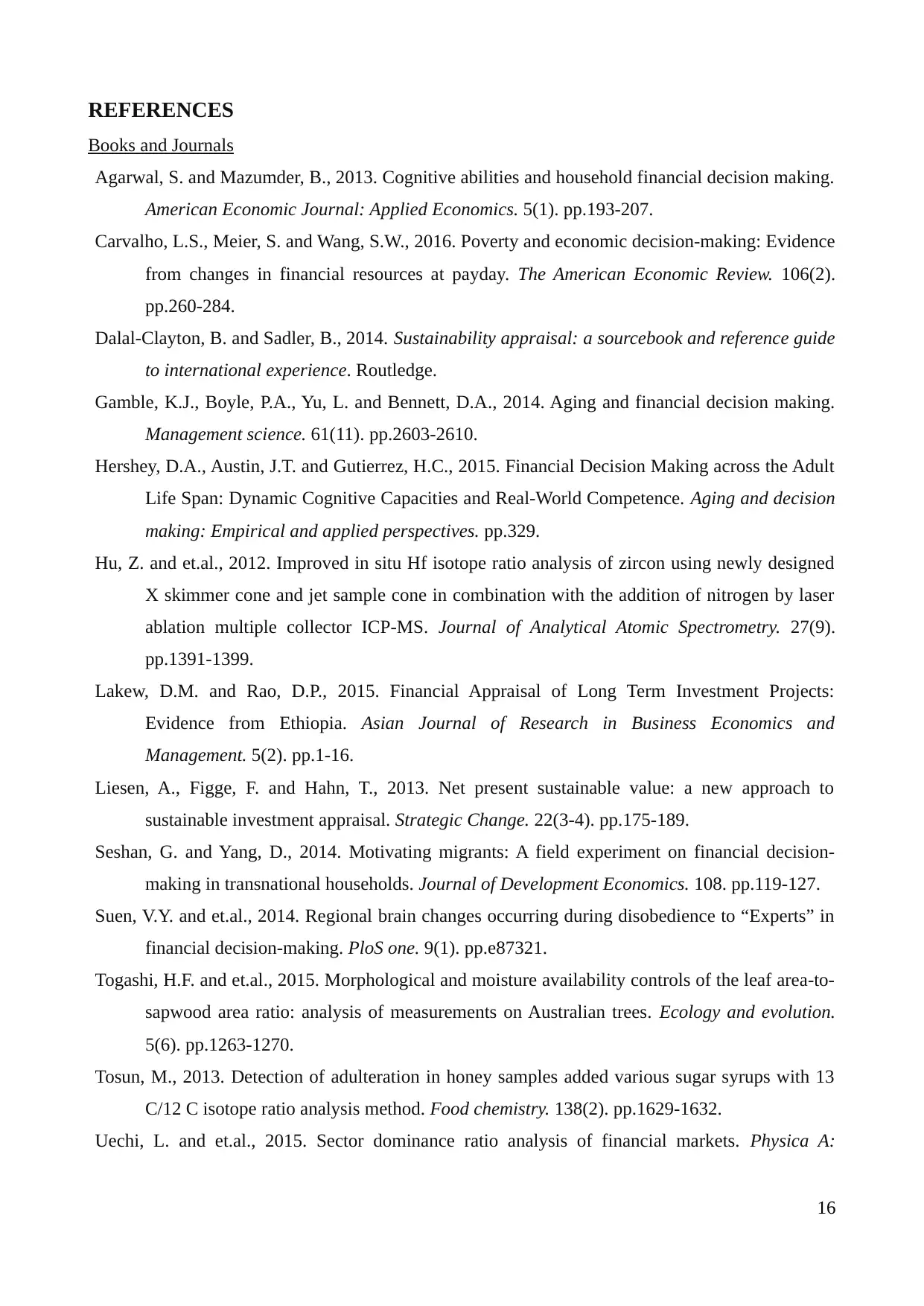
REFERENCES
Books and Journals
Agarwal, S. and Mazumder, B., 2013. Cognitive abilities and household financial decision making.
American Economic Journal: Applied Economics. 5(1). pp.193-207.
Carvalho, L.S., Meier, S. and Wang, S.W., 2016. Poverty and economic decision-making: Evidence
from changes in financial resources at payday. The American Economic Review. 106(2).
pp.260-284.
Dalal-Clayton, B. and Sadler, B., 2014. Sustainability appraisal: a sourcebook and reference guide
to international experience. Routledge.
Gamble, K.J., Boyle, P.A., Yu, L. and Bennett, D.A., 2014. Aging and financial decision making.
Management science. 61(11). pp.2603-2610.
Hershey, D.A., Austin, J.T. and Gutierrez, H.C., 2015. Financial Decision Making across the Adult
Life Span: Dynamic Cognitive Capacities and Real-World Competence. Aging and decision
making: Empirical and applied perspectives. pp.329.
Hu, Z. and et.al., 2012. Improved in situ Hf isotope ratio analysis of zircon using newly designed
X skimmer cone and jet sample cone in combination with the addition of nitrogen by laser
ablation multiple collector ICP-MS. Journal of Analytical Atomic Spectrometry. 27(9).
pp.1391-1399.
Lakew, D.M. and Rao, D.P., 2015. Financial Appraisal of Long Term Investment Projects:
Evidence from Ethiopia. Asian Journal of Research in Business Economics and
Management. 5(2). pp.1-16.
Liesen, A., Figge, F. and Hahn, T., 2013. Net present sustainable value: a new approach to
sustainable investment appraisal. Strategic Change. 22(3‐4). pp.175-189.
Seshan, G. and Yang, D., 2014. Motivating migrants: A field experiment on financial decision-
making in transnational households. Journal of Development Economics. 108. pp.119-127.
Suen, V.Y. and et.al., 2014. Regional brain changes occurring during disobedience to “Experts” in
financial decision-making. PloS one. 9(1). pp.e87321.
Togashi, H.F. and et.al., 2015. Morphological and moisture availability controls of the leaf area‐to‐
sapwood area ratio: analysis of measurements on Australian trees. Ecology and evolution.
5(6). pp.1263-1270.
Tosun, M., 2013. Detection of adulteration in honey samples added various sugar syrups with 13
C/12 C isotope ratio analysis method. Food chemistry. 138(2). pp.1629-1632.
Uechi, L. and et.al., 2015. Sector dominance ratio analysis of financial markets. Physica A:
16
Books and Journals
Agarwal, S. and Mazumder, B., 2013. Cognitive abilities and household financial decision making.
American Economic Journal: Applied Economics. 5(1). pp.193-207.
Carvalho, L.S., Meier, S. and Wang, S.W., 2016. Poverty and economic decision-making: Evidence
from changes in financial resources at payday. The American Economic Review. 106(2).
pp.260-284.
Dalal-Clayton, B. and Sadler, B., 2014. Sustainability appraisal: a sourcebook and reference guide
to international experience. Routledge.
Gamble, K.J., Boyle, P.A., Yu, L. and Bennett, D.A., 2014. Aging and financial decision making.
Management science. 61(11). pp.2603-2610.
Hershey, D.A., Austin, J.T. and Gutierrez, H.C., 2015. Financial Decision Making across the Adult
Life Span: Dynamic Cognitive Capacities and Real-World Competence. Aging and decision
making: Empirical and applied perspectives. pp.329.
Hu, Z. and et.al., 2012. Improved in situ Hf isotope ratio analysis of zircon using newly designed
X skimmer cone and jet sample cone in combination with the addition of nitrogen by laser
ablation multiple collector ICP-MS. Journal of Analytical Atomic Spectrometry. 27(9).
pp.1391-1399.
Lakew, D.M. and Rao, D.P., 2015. Financial Appraisal of Long Term Investment Projects:
Evidence from Ethiopia. Asian Journal of Research in Business Economics and
Management. 5(2). pp.1-16.
Liesen, A., Figge, F. and Hahn, T., 2013. Net present sustainable value: a new approach to
sustainable investment appraisal. Strategic Change. 22(3‐4). pp.175-189.
Seshan, G. and Yang, D., 2014. Motivating migrants: A field experiment on financial decision-
making in transnational households. Journal of Development Economics. 108. pp.119-127.
Suen, V.Y. and et.al., 2014. Regional brain changes occurring during disobedience to “Experts” in
financial decision-making. PloS one. 9(1). pp.e87321.
Togashi, H.F. and et.al., 2015. Morphological and moisture availability controls of the leaf area‐to‐
sapwood area ratio: analysis of measurements on Australian trees. Ecology and evolution.
5(6). pp.1263-1270.
Tosun, M., 2013. Detection of adulteration in honey samples added various sugar syrups with 13
C/12 C isotope ratio analysis method. Food chemistry. 138(2). pp.1629-1632.
Uechi, L. and et.al., 2015. Sector dominance ratio analysis of financial markets. Physica A:
16
Secure Best Marks with AI Grader
Need help grading? Try our AI Grader for instant feedback on your assignments.
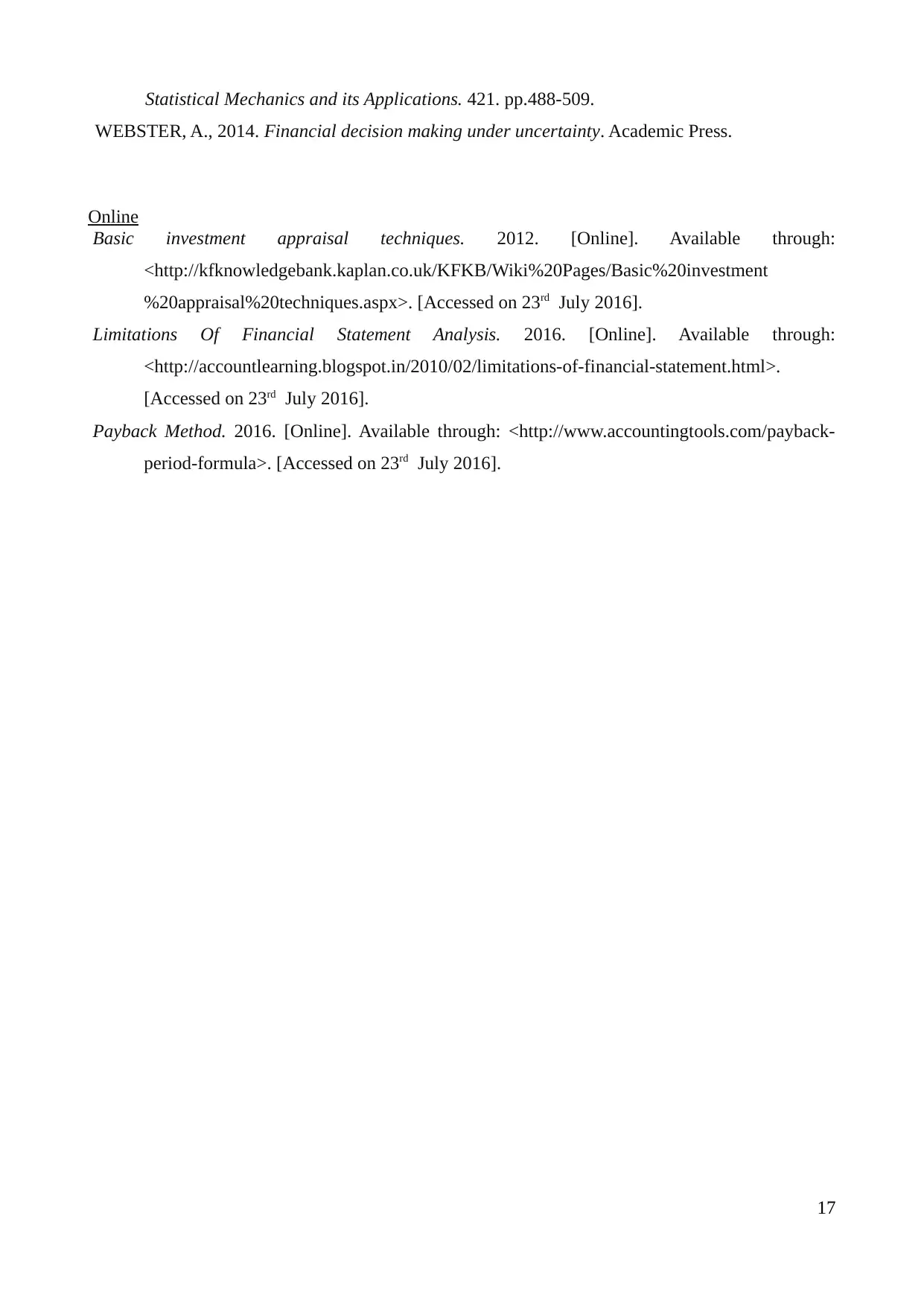
Statistical Mechanics and its Applications. 421. pp.488-509.
WEBSTER, A., 2014. Financial decision making under uncertainty. Academic Press.
Online
Basic investment appraisal techniques. 2012. [Online]. Available through:
<http://kfknowledgebank.kaplan.co.uk/KFKB/Wiki%20Pages/Basic%20investment
%20appraisal%20techniques.aspx>. [Accessed on 23rd July 2016].
Limitations Of Financial Statement Analysis. 2016. [Online]. Available through:
<http://accountlearning.blogspot.in/2010/02/limitations-of-financial-statement.html>.
[Accessed on 23rd July 2016].
Payback Method. 2016. [Online]. Available through: <http://www.accountingtools.com/payback-
period-formula>. [Accessed on 23rd July 2016].
17
WEBSTER, A., 2014. Financial decision making under uncertainty. Academic Press.
Online
Basic investment appraisal techniques. 2012. [Online]. Available through:
<http://kfknowledgebank.kaplan.co.uk/KFKB/Wiki%20Pages/Basic%20investment
%20appraisal%20techniques.aspx>. [Accessed on 23rd July 2016].
Limitations Of Financial Statement Analysis. 2016. [Online]. Available through:
<http://accountlearning.blogspot.in/2010/02/limitations-of-financial-statement.html>.
[Accessed on 23rd July 2016].
Payback Method. 2016. [Online]. Available through: <http://www.accountingtools.com/payback-
period-formula>. [Accessed on 23rd July 2016].
17
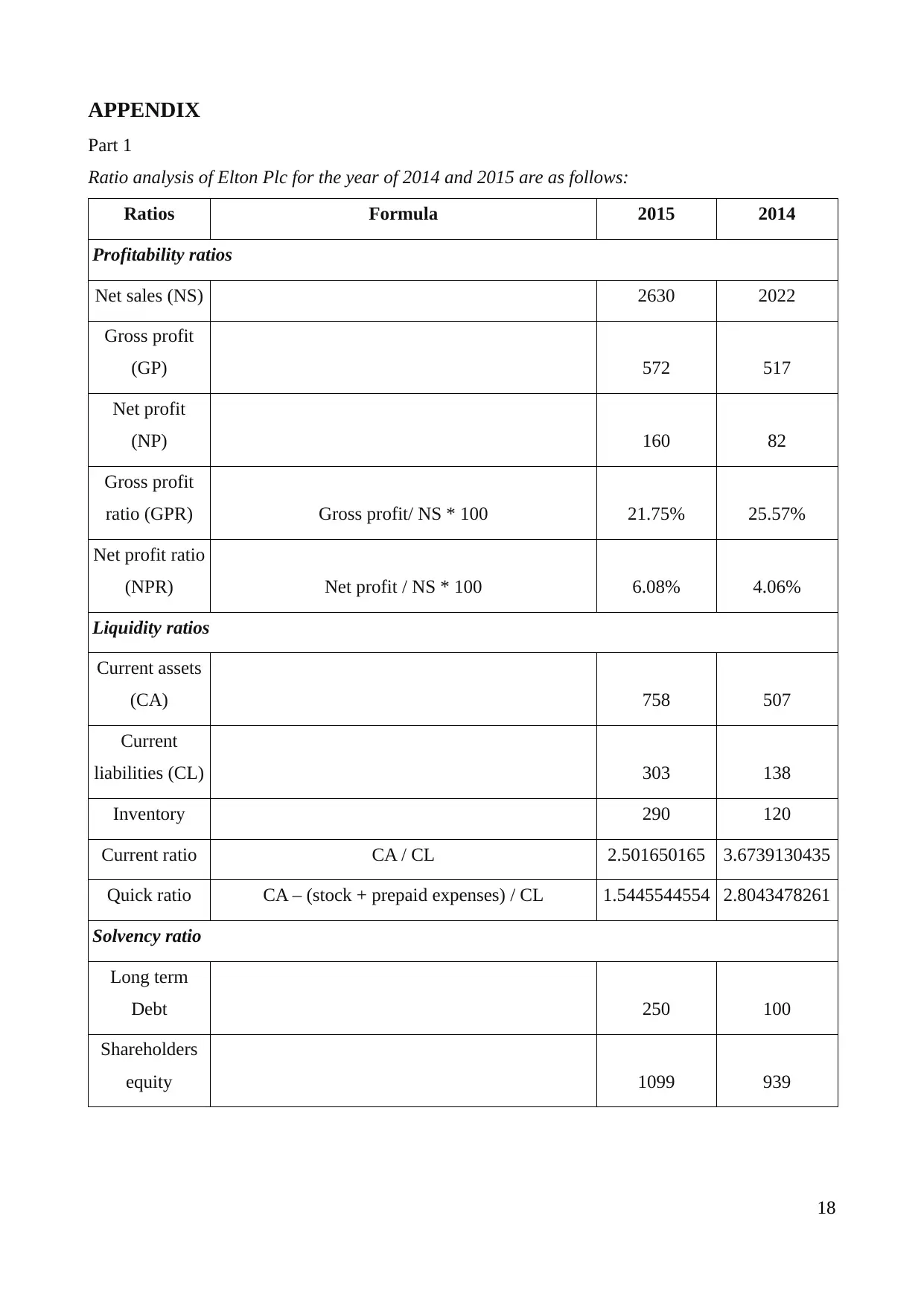
APPENDIX
Part 1
Ratio analysis of Elton Plc for the year of 2014 and 2015 are as follows:
Ratios Formula 2015 2014
Profitability ratios
Net sales (NS) 2630 2022
Gross profit
(GP) 572 517
Net profit
(NP) 160 82
Gross profit
ratio (GPR) Gross profit/ NS * 100 21.75% 25.57%
Net profit ratio
(NPR) Net profit / NS * 100 6.08% 4.06%
Liquidity ratios
Current assets
(CA) 758 507
Current
liabilities (CL) 303 138
Inventory 290 120
Current ratio CA / CL 2.501650165 3.6739130435
Quick ratio CA – (stock + prepaid expenses) / CL 1.5445544554 2.8043478261
Solvency ratio
Long term
Debt 250 100
Shareholders
equity 1099 939
18
Part 1
Ratio analysis of Elton Plc for the year of 2014 and 2015 are as follows:
Ratios Formula 2015 2014
Profitability ratios
Net sales (NS) 2630 2022
Gross profit
(GP) 572 517
Net profit
(NP) 160 82
Gross profit
ratio (GPR) Gross profit/ NS * 100 21.75% 25.57%
Net profit ratio
(NPR) Net profit / NS * 100 6.08% 4.06%
Liquidity ratios
Current assets
(CA) 758 507
Current
liabilities (CL) 303 138
Inventory 290 120
Current ratio CA / CL 2.501650165 3.6739130435
Quick ratio CA – (stock + prepaid expenses) / CL 1.5445544554 2.8043478261
Solvency ratio
Long term
Debt 250 100
Shareholders
equity 1099 939
18
1 out of 18
Related Documents
Your All-in-One AI-Powered Toolkit for Academic Success.
+13062052269
info@desklib.com
Available 24*7 on WhatsApp / Email
![[object Object]](/_next/static/media/star-bottom.7253800d.svg)
Unlock your academic potential
© 2024 | Zucol Services PVT LTD | All rights reserved.





